In Albert Einstein’s footsteps
The European Organization for Nuclear Research examines the structure of matter. Its latest construction is already underway: named CERN B777 and designed by Henning Larsen, the new research centre will be round and mostly made of wood.
On 30 June 1905 Albert Einstein published his theory of special relativity, which explains the connection between time and space using the famous equation E = mc². Numerous aspects of this theory have been confirmed in experiments at the Centre Européen pour la Récherche Nucleaire (CERN). Situated near Geneva, the research institute is home to the particle accelerator Large Hadron Collider (LHC). This has raised its global profile – together with the fact that a British scientist also invented the World Wide Web here.
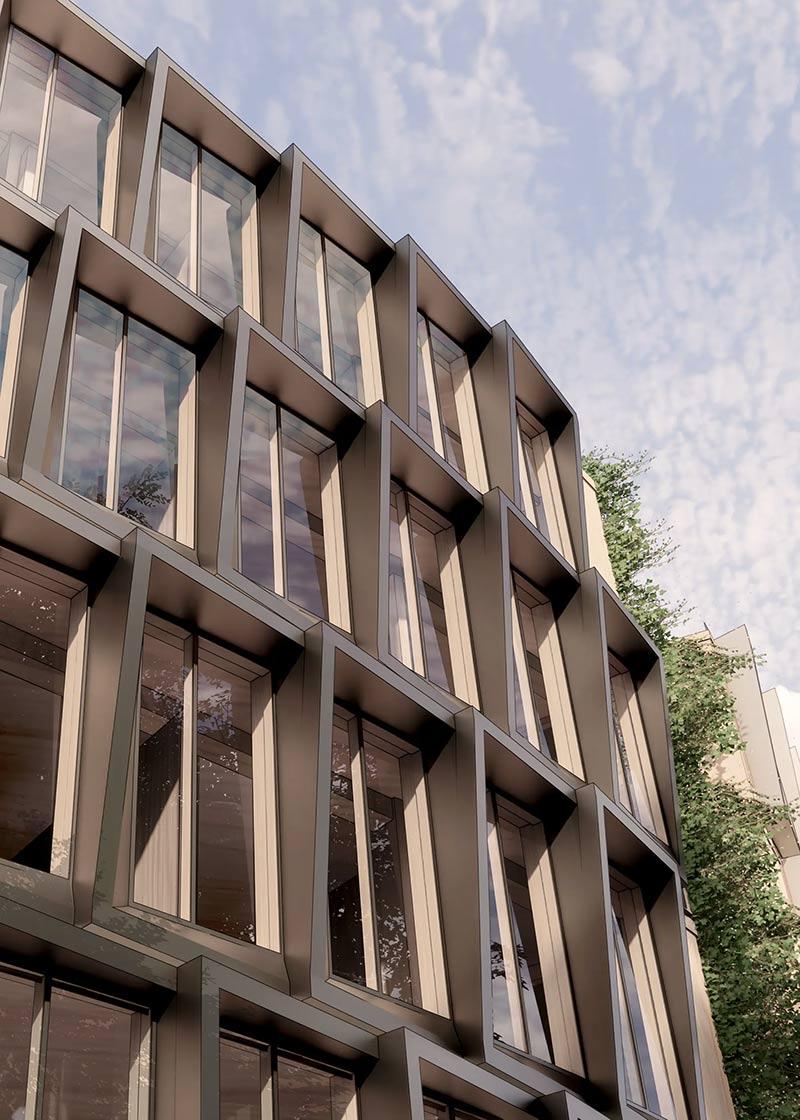
A new building is now being constructed at CERN’s Prévessin campus, on the French side of the border. Named B777, it has several special features. These range from the use of timber as a renewable building material to the parametric design of the facade which minimizes direct sunlight at midday and therefore saves energy. The architects at Danish studio Henning Larsen have created a striking, round construction that is comprehensively low-emission and climate-friendly.
A nature-inclusive highlight
The CERN research centre straddles the border of Switzerland and France. Since it was founded in 1952, it has served as the European epicentre of scientific innovation. Taking a similar approach to Danone’s new research centre In’Cube to the south-west of Paris, B777 has little in common with the buttoned-up inaccessibility of conventional industry and research buildings. Rather, it will be a new build that reflects the CERN mission, which is to bring scientists together on a common search for knowledge.
Our vision is to craft a dynamic workspace at the heart of nature – a place where well-being, collaboration and knowledge thrive.
Søren Øllgaard, Design Director Europe at Henning Larsen
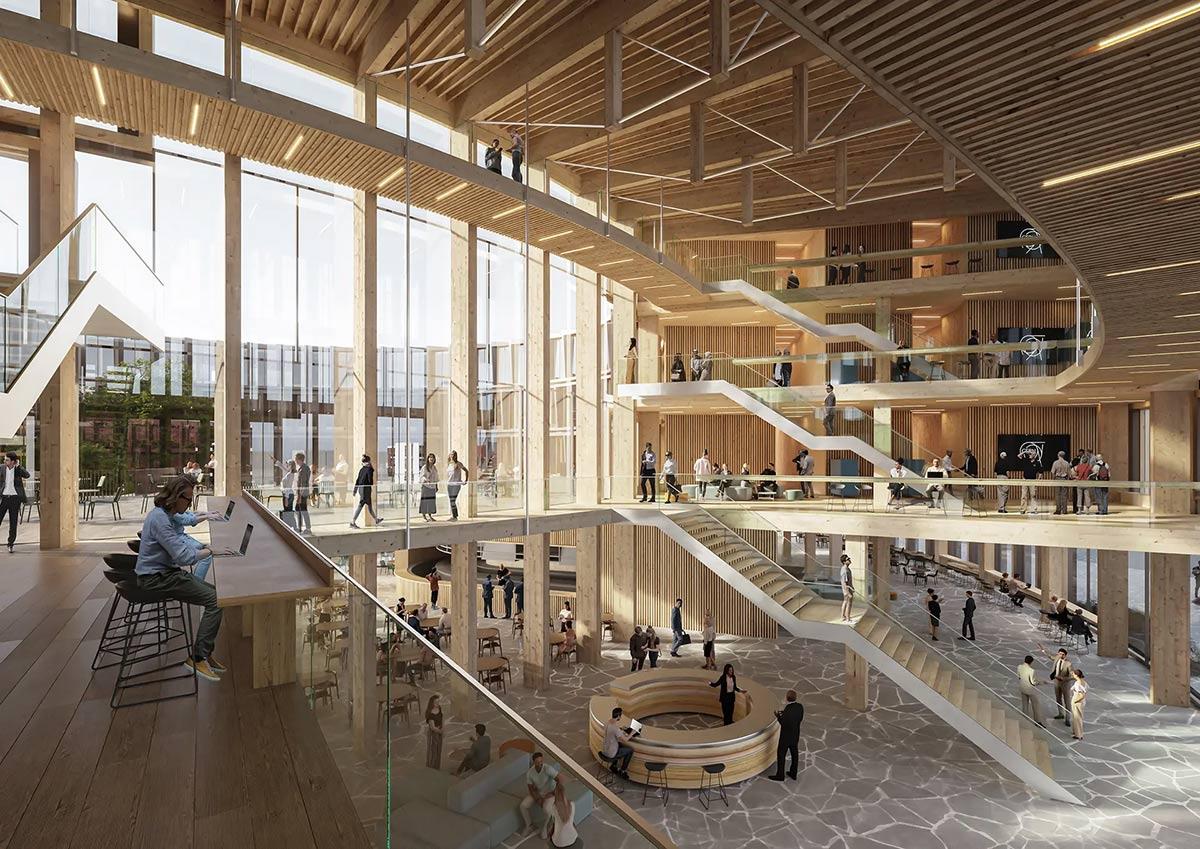
Its open, circular form responds to this aspiration together with the recognizable commission of creating an attractive, nature-inclusive place where researchers like to work together. Describing the design, Henning Larsen’s Design Director Europe Søren Øllgaard explains: “Our vision is to craft a dynamic workspace at the heart of nature – a place where well-being, collaboration and knowledge thrive. It’s not just an ordinary office; the circular design serves as a symbolic marker, creating a cultural hub and amenity centre for the entire campus.”
Feel-good architecture as new mantra
Overall, the new research building presents 13,000 square metres of space for offices, laboratories and workshops, which are dominated by natural wood surfaces and plenty of daylight. Instead of the windowless corridors so typical of research institutes in earlier days, the building’s spatial concept is open and transparent. The soft feel of the wood automatically conjures up a feeling of comfort. In current times, when talented professionals are sought after in the fight for the best employees, feel-good architecture is turning into the new mantra.
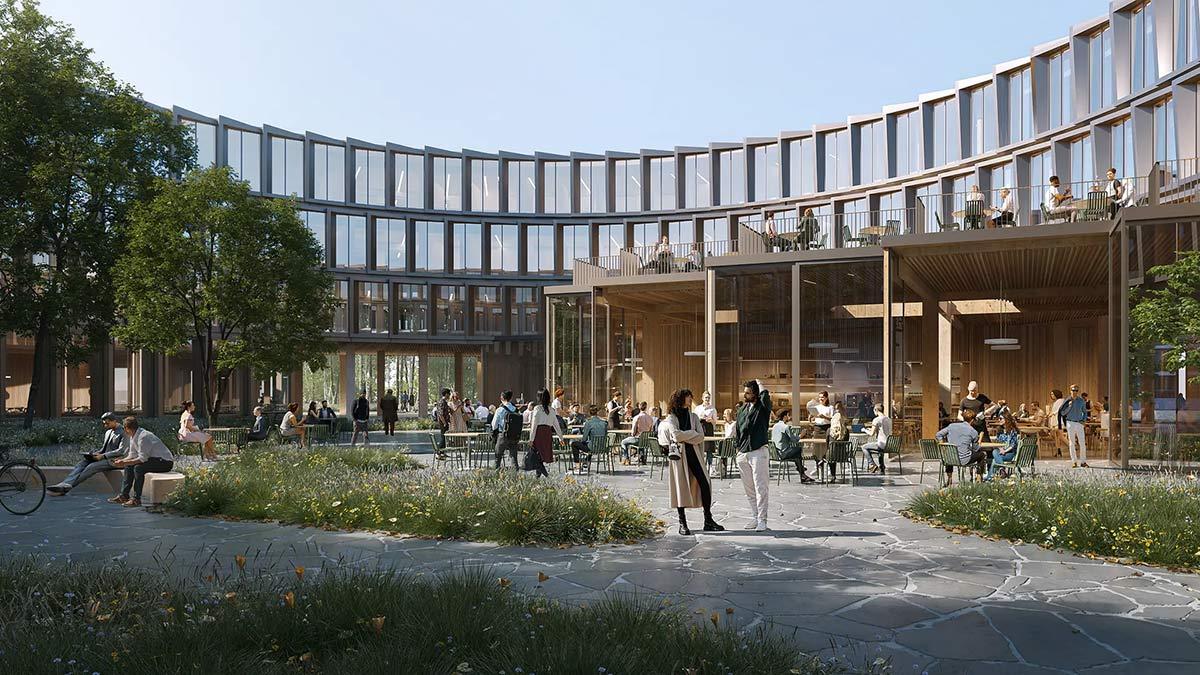
At the entrance to the building, a light-filled atrium opens up across all four storeys and enables the whole building to be viewed at a single glance. Timber stairs connect the individual floors, bridges soar high above the ground floor and create short routes and fascinating sightlines. Despite the sheer size of this atrium, it has a decidedly cosy feeling with rustic stone floor and warm wooden finish. Describing the aim of the design, the studio Henning Larsen comments: “This innovative space is imagined as a home away from home for employees.”
This innovative space is imagined as a home away from home for employees.
Henning Larsen, architectural studio
There is a simple reason why hospitality areas are becoming ever more important when new office buildings are developed. They persuade people to leave their office cells, and in times of increasing digitalization they provide an environment for unplanned, informal interaction. Nowadays, we know that such coincidental meetings are at least as important for the success of projects as focused working in a quiet room. It is an approach that is also known as the serendipity principle.
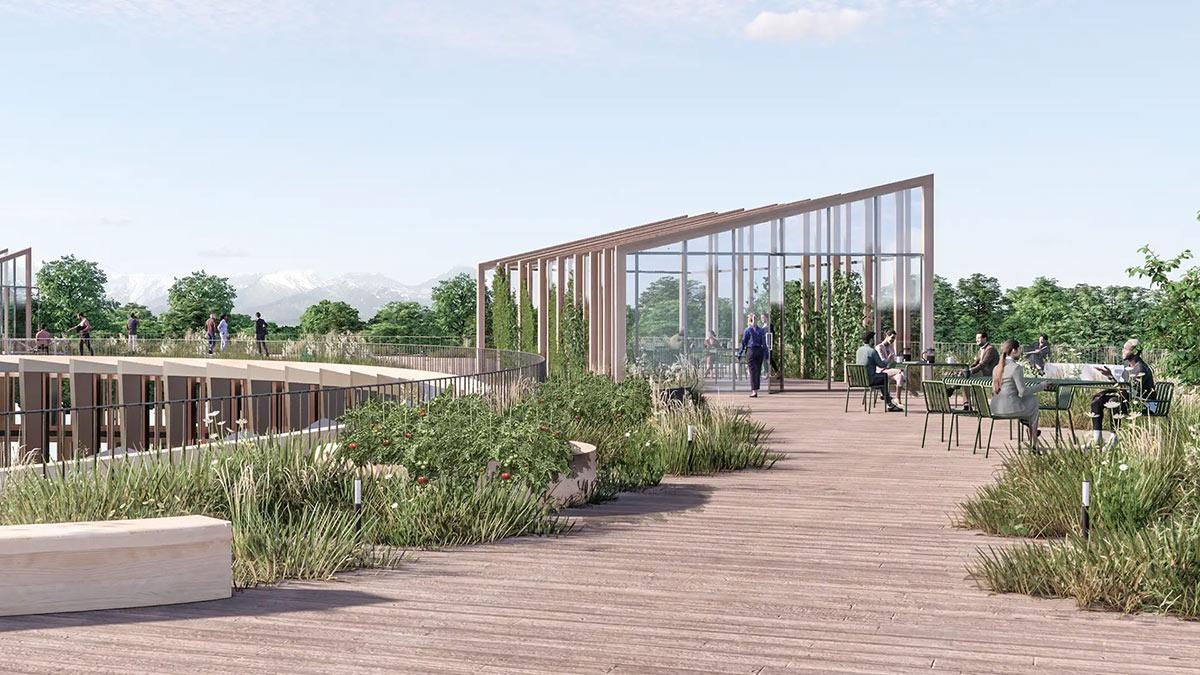
Working in greenery
The greened courtyard at B777 is open and free-flowing, and therefore provides a sheltered space with pleasant temperatures throughout the year. Henning Larsen’s architects were inspired by the surrounding area: “Drawing inspiration from the protected plazas at the heart of nearby Alpine villages, the central courtyard of the building will offer an optimized microclimate tailored to location conditions.”
With its openings on two sides, the courtyard acts like a green link – stretching between a small woodland area on one side of the building and a park on the other – that promotes biodiversity. Floor-to-ceiling glazing on all sides creates a connection between interior and exterior. Informal meeting zones in the fresh air extend the office space outside and enable outdoor working amongst greenery when the weather is pleasant.
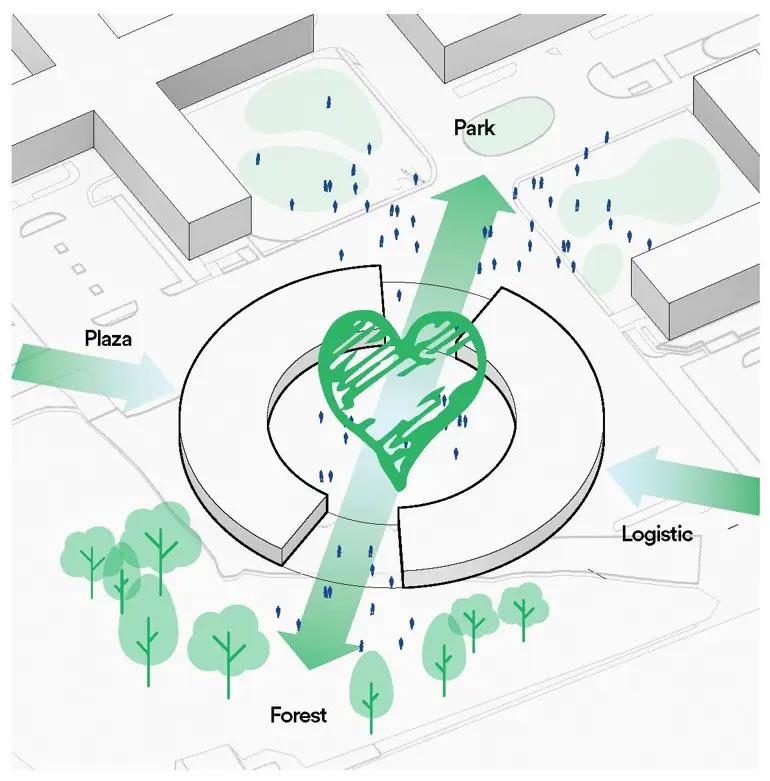
Nature as an antidote to stress
Biophilic architecture is the new buzzword when it comes to stimulating the creativity of employees and boosting their mental health. Only recently, ecologist MaryCarol Hunter and her team at the University of Michigan were able to prove that just 20 minutes spent in green space significantly reduces the level of stress hormones. Which means that looking out of your office across a green landscape could ideally even benefit your health.
Albert Einstein himself was already aware that the world of nature is hugely important for insight and discovery. As he remarked: “Look deep into nature, and then you will understand everything better.”
Text: Gertraud Gerst
Translation: Rosemary Bridger-Lippe
Visualizations: Vivid-Vision
Free-floating and functional
The TUM Campus at Munich’s Olympiapark shows how a carefully planned timber project can save resources and the associated costs. Shortlisted for the DAM Preis 2024, it was formerly Europe’s largest timber construction.
Even after more than 50 years, the famous acrylic glass tent roof on Munich’s Olympic Stadium continues to impress. The design by Günter Behnisch and Frei Otto still has the potential to overshadow new builds nearby, despite its transparency and sense of lightness. Conversely, there is also the risk that this architectural heritage will pale in comparison when confronted by neighbouring new projects. Either way, integrating fresh designs into this context is a complex challenge that the team of architects at Dietrich Untertrifaller have expertly mastered with their new TUM Campus.
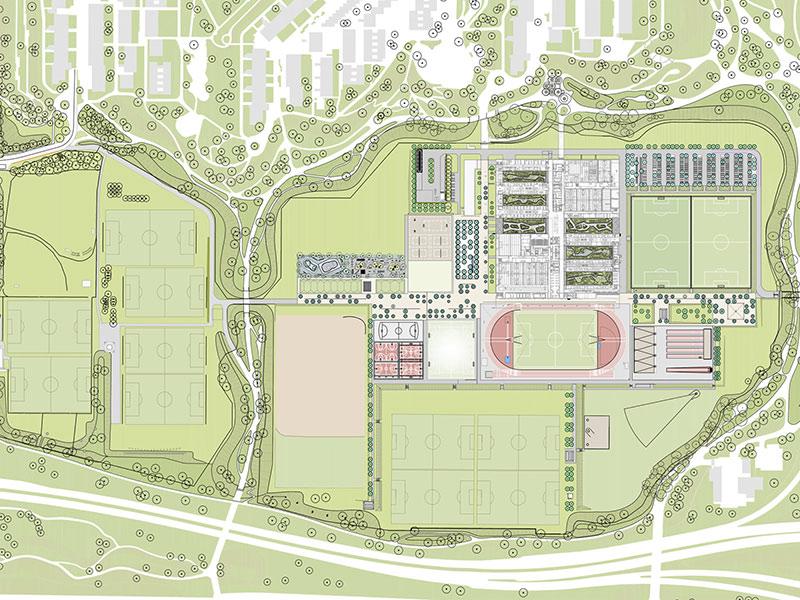
A superlative for timber construction
Adopting the same approach as the 1972 Olympic structures, the roof of the TUM Campus plays a significant role in the overall design. This 19-metre cantilevered canopy seems to float effortlessly above the running track over a length of 153 metres. Besides acting as a protective covering over the spectator stands, it also provides ideal conditions for the sports labs on the ground floor as sports performances can be measured here with less exposure to the weather. The design decisions were therefore all clearly taken with functional considerations in mind.
‘Light, freshness, generosity’: To this day, the slogan of the 1972 Munich Olympic Games still applies to our design in Munich’s listed Olympic Park.
Dietrich Untertrifaller, architectural studio
The whole complex, which houses the TUM School of Medicine and Health – a faculty of Munich Technical University – was Europe’s largest timber construction when it was first developed. It opened in 2023 and is now used by 125,000 students and 30,000 university staff. With the reticence of its design and the horizontal focus, it slots almost naturally into the Olympic setting without trying to compete with its iconic surroundings.
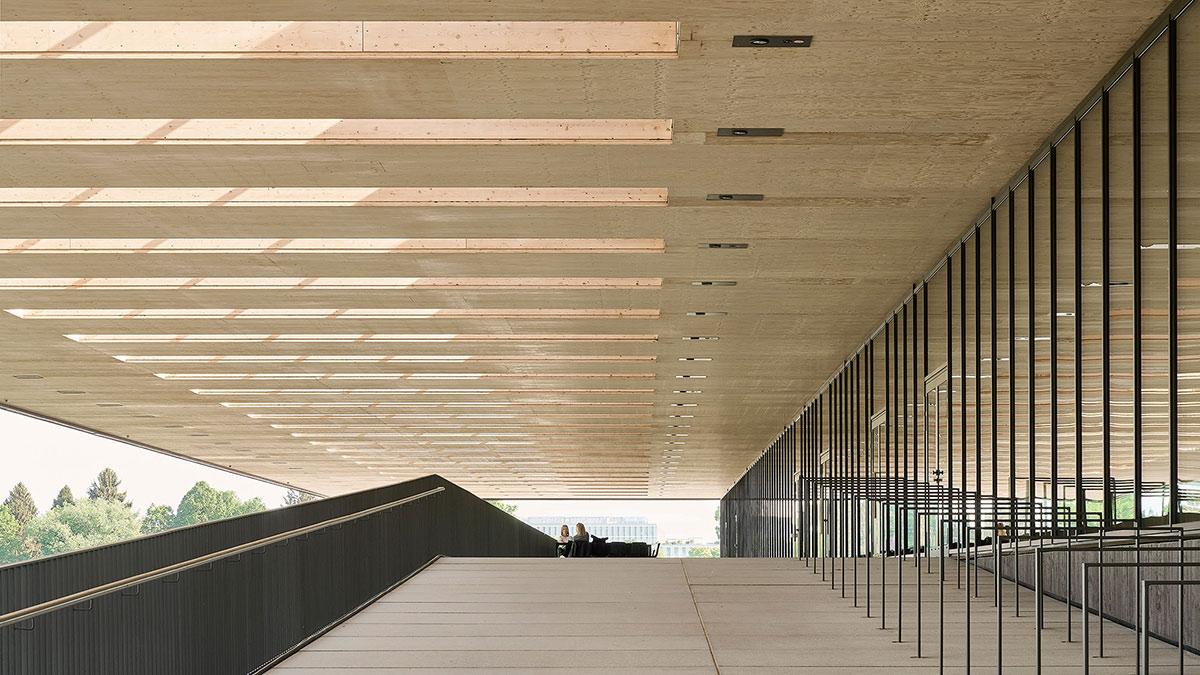
Connected by the rue interieure
“‘Light, freshness, generosity’: To this day, the slogan of the 1972 Munich Olympic Games still applies to the TUM School of Medicine and Health in Munich’s listed Olympic Park,” the architects explain in their concept. Based in Bregenz, the architectural studio Dietrich Untertrifaller – which has branch offices in Vienna, Munich, Paris and St. Gallen – won the competition together with landscape architects Balliana-Schubert from Zurich.
While the designs by other competitors were inspired formally by the iconic tent roof or conceal the buildings under a grassed roof, the winning design is reduced to the essentials. The description continues: “The clearly structured complex is divided into two hall and institute clusters along a central access axis. This ‘rue interieure’ runs through the entire building from east to west”, which also creates a communication zone. Floor-to-ceiling glazing allows a clear view of the individual sports halls, generating transparent and comprehensible space.
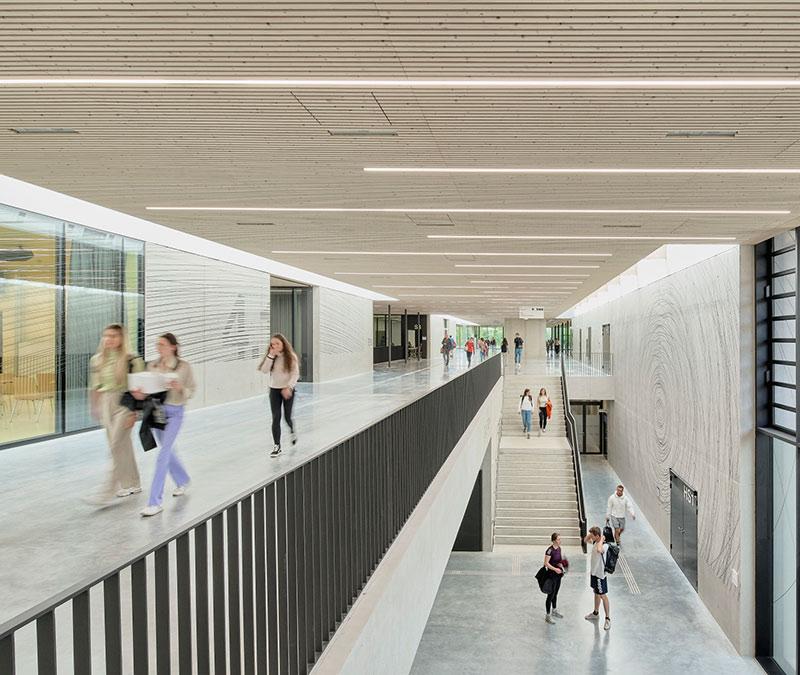
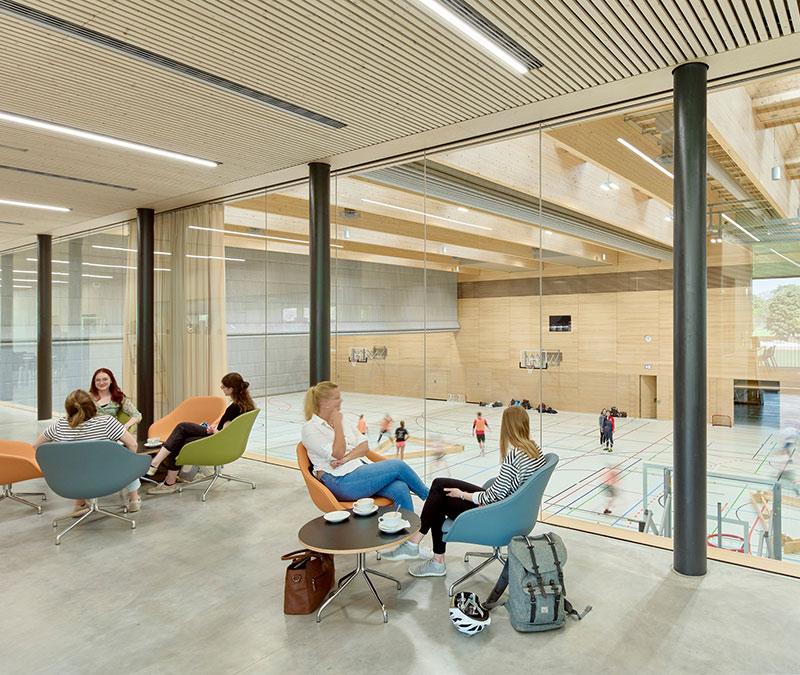
Timber construction benefits fire safety
The costs were a crucial reason for selecting this design, as architect Much Untertrifaller explained to “Detail” magazine: “Our design was by far the most affordable. Wood is sustainable and has been affordable until now because unlike steel, it does not have to be protected with fire-prevention coatings.” Whereas fire safety used to be the greatest obstacle for timber building, wood is now considered a safety benefit in this respect. Unlike steel, timber allows burning to be controlled and a protective charcoal layer also forms on the surface of the wood. Therefore, the core of loadbearing structures is protected from harm for a long time.
Our design was by far the most affordable.
Dietrich Untertrifaller, architectural studio
The secret behind this spectacular projecting roof, which requires no additional supports, is a special lightweight construction made of prefabricated glulam parts from timber engineers Rubner Holzbau. The individual prefabricated elements are 28 metres long and 3.75 metres wide, and consist of commercially available veneer plywood and glulam ribs. These were glued together at the factory to form box girder elements with high rigidity and minimal self-weight, which enabled economically justifiable production costs.
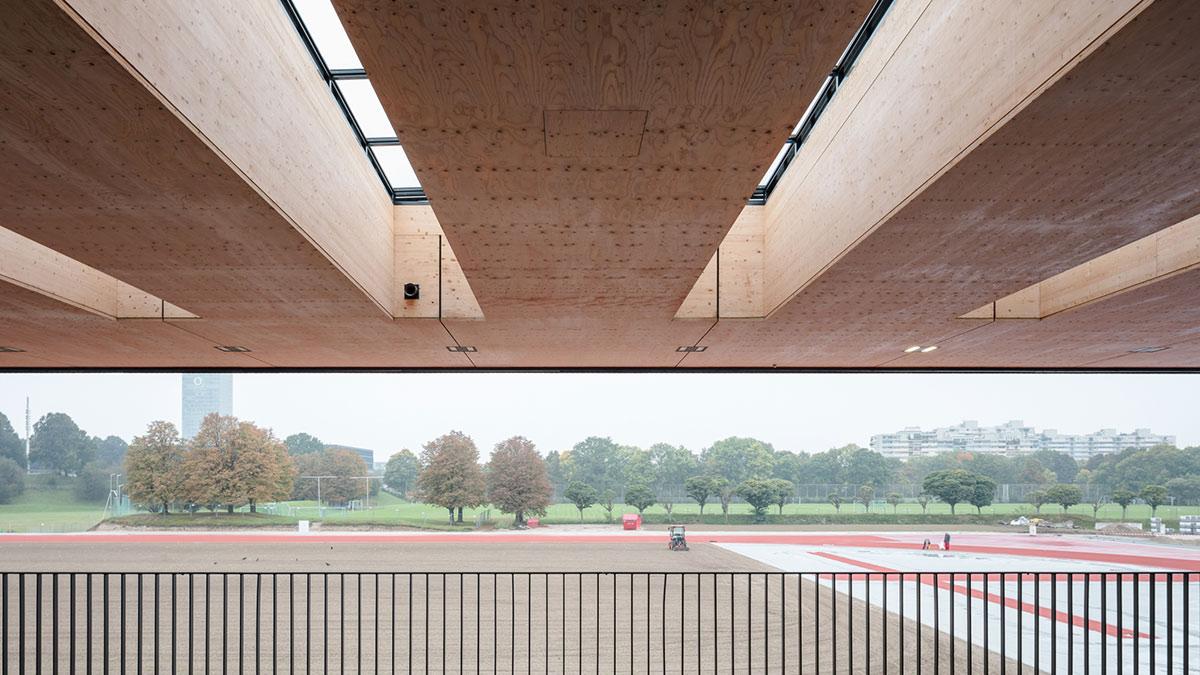
Hall cluster built in two months
The TUM Campus has an overall hybrid design. While some sections – such as the basement and central access axis – use reinforced concrete, the sports halls, institute areas and the entire roof are designed with timber. The high degree of prefabrication also enabled the timber elements to be assembled quickly. According to the project description: “With perfect logistics for planning, production, delivery and assembly, the hall clusters were erected in just two months.”
However, the architects’ selection of materials followed a different line of thought. “Timber was chosen to preserve the link between landscape and architecture,” they say. The same link is established by the listed Olympic structures.
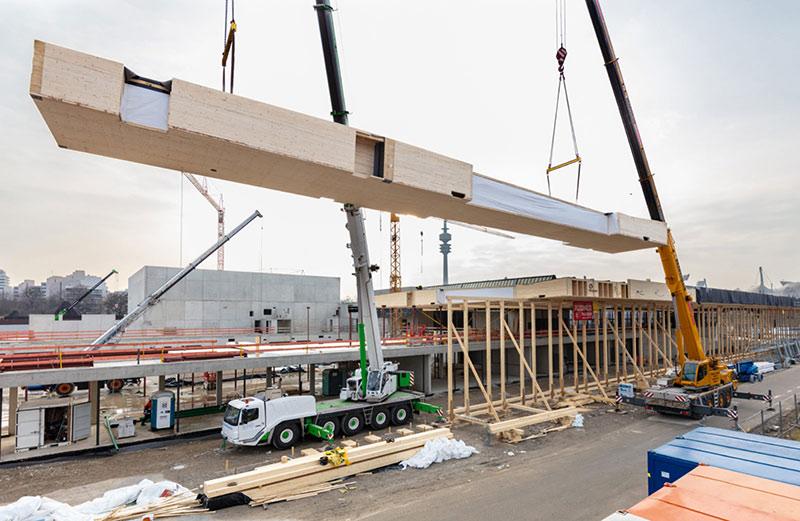
Frei Otto, whose visionary Multihalle in Mannheim is undergoing extensive renovation, was continually on the search for new and free forms of construction. The new TUM Campus uses the lightness of a timber design and adopts this pioneering spirit, showing how a large building project can be implemented with an unequivocal, resource-friendly approach. It is a self-assured addition to the Olympiapark and a structure that expresses the current architectural zeitgeist. While maintaining sensitivity for the context and conscious handling of planetary limits.
The TU Munich Campus won the Austrian Green Planet Building Award and was shortlisted for the DAM Preis 2024.
Text: Gertraud Gerst
Translation: Rosemary Bridger-Lippe
Photos: Aldo Amoretti, Marcus Buck, David Matthiessen
McDonald’s builds with timber
São Paulo is home to Brazil’s “most sustainable McDonald’s”. It has a timber design and is presented as an educational project for sustainable building. For the company, the wooden structure is a “recipe for the future”.
There is hardly a better sign that timber construction is gradually becoming accepted by the industry’s mainstream. When US fast food giant McDonald’s opens a branch built out of wood at one of the busiest intersections in São Paulo, it is a clear message for the world. According to architects SuperLimão Studio, who were responsible for the design for this ambitious new build, it is “the most sustainable McDonald’s in Brazil”.
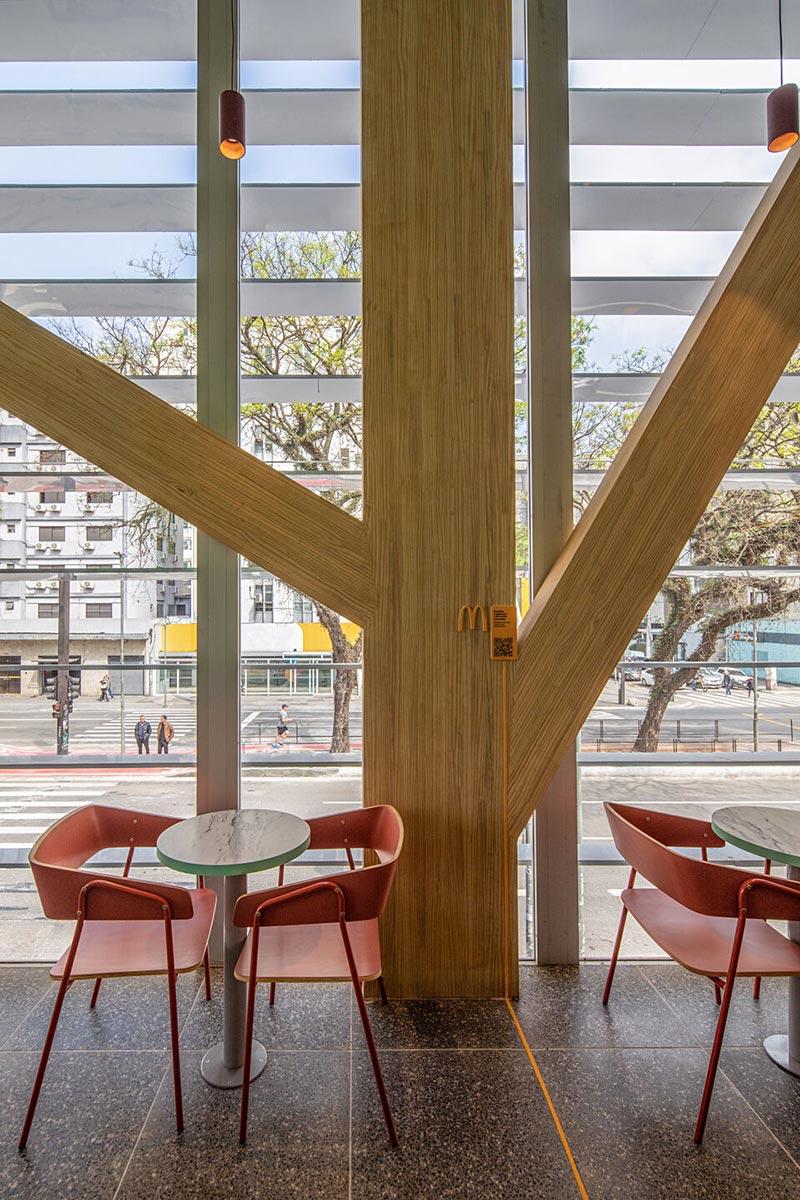
Biometric timber-framed design
For their raised wooden building, the architects found their inspiration in nature – in the image of a tree. The mass timber columns that extend from the base to the ceiling of the upper storey divide into several branches towards the top, in a tree-like structure. This asymmetrical diagonal bracing is clearly visible from outside, through the floor-to-ceiling glazing.
Taking a biometric approach to the design, the team of architects oriented their work on the trees in nearby Avenida Bernardino de Campos, where it is said that the final remaining trees in this urban district grow. Along with the horizontal sunshading, the greened restaurant roof is designed to help regulate the interior temperature naturally. Rainwater and air conditioning condensate are collected and treated.
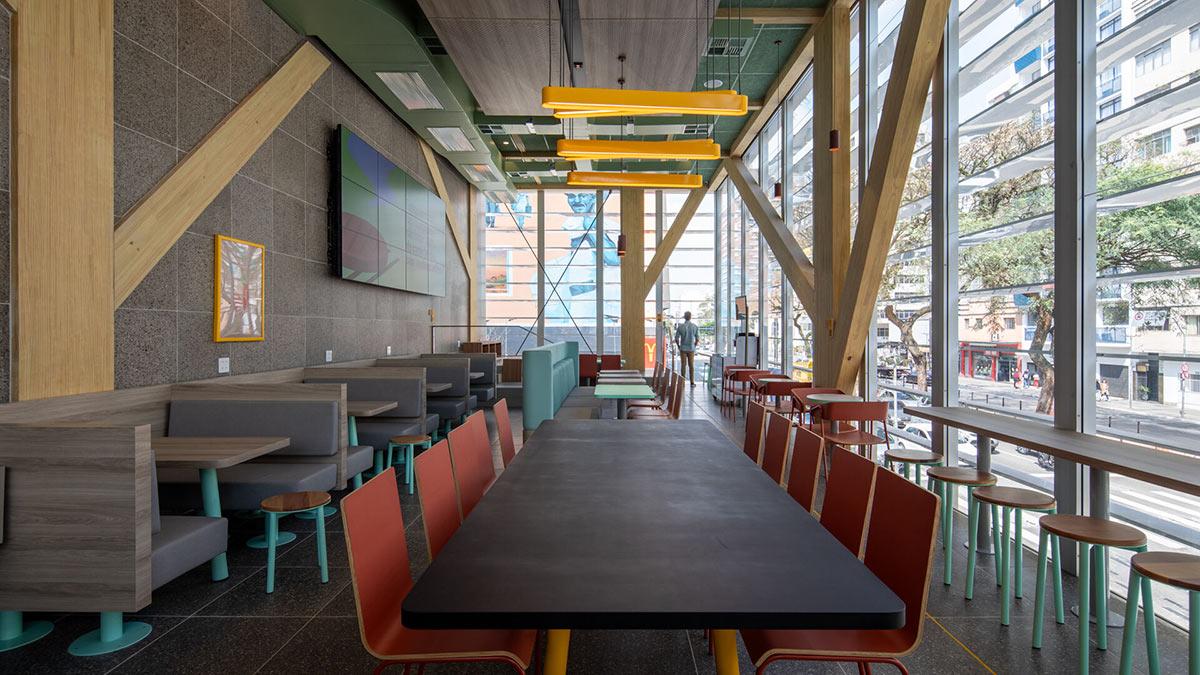
Timber Méqui as environmental ambassador
At its prominent site in the city of São Paulo, this timber Méqui opened in 2023 as a visible example of sustainable construction. “Since environmental awareness is just as important as actions, we decided to go beyond the project itself, turning it into a powerful tool for environmental education and awareness,” explains Lula Gouveia, architect and partner at SuperLimão.
Since environmental awareness is just as important as actions, we decided to go beyond the project itself, turning it into a powerful tool for environmental education.
Lula Gouveia, architect and partner at SuperLimão
Yellow floor markings guide visitors through the restaurant like a nature trail. Corresponding QR codes throughout the branch explain the sustainability relevance of certain materials and building materials. For the interior design and furnishings, conventional options were replaced with more sustainable alternatives from local manufacturers wherever possible. For example, the team says that recycled PET laminate was chosen instead of melamine.
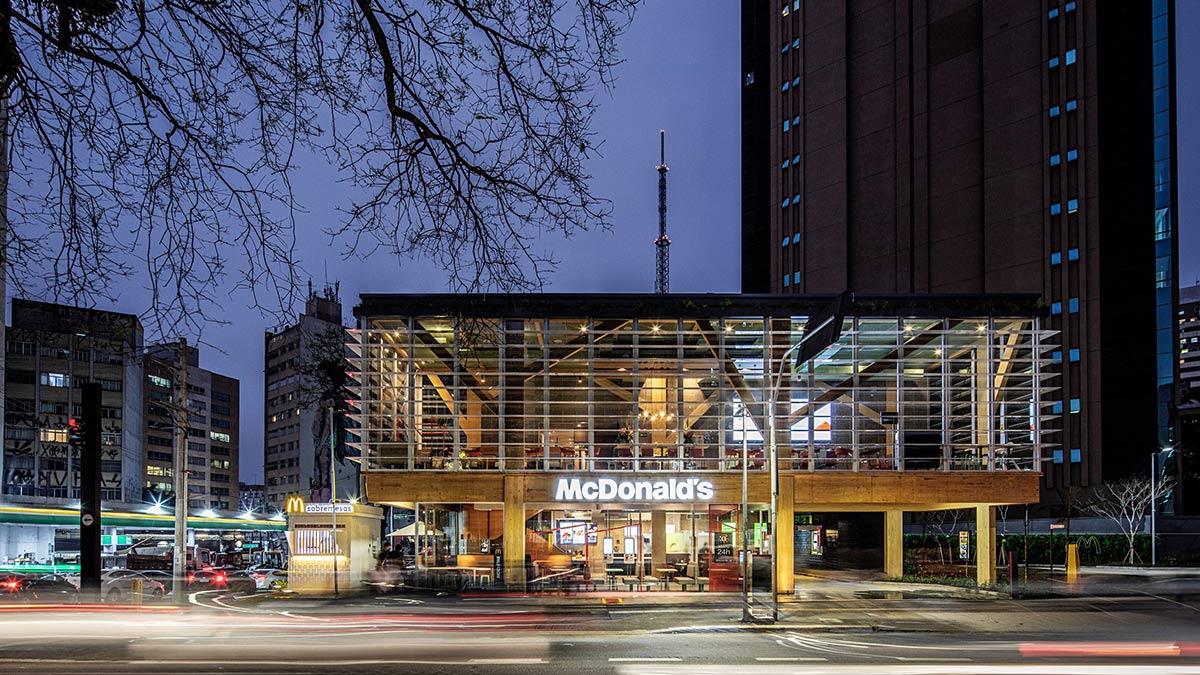
Extensive prefabrication of the timber support structure also saved resources, reduced energy consumption and shortened construction time. The architects have not revealed the source of the wood used for the restaurant’s support structure.
Brazil’s massive deforestation
However, one thing is clear: Brazil is still far from achieving sustainable forestry. In 2022 alone, the country lost around 33,000 square kilometres of forest area, according to statistics platform Statista. These trees had to make way for either commercial agricultural production or shifting cultivation.
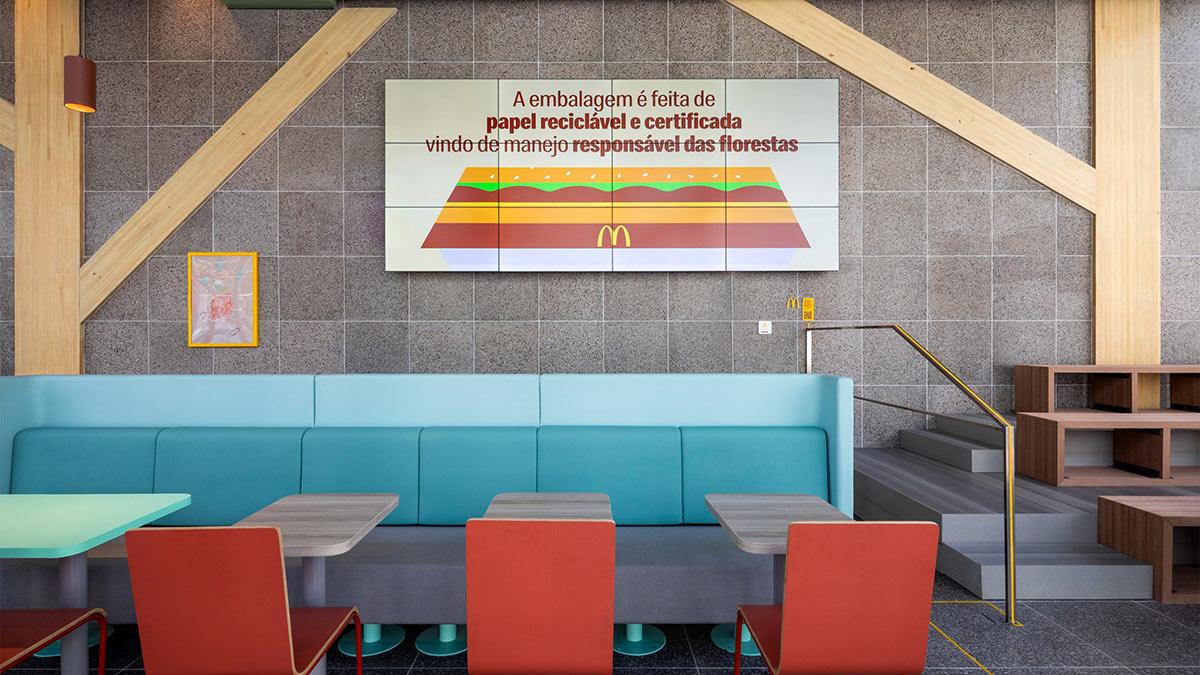
And the forests that remain are increasingly threatened by climate change, in the form of extreme weather, drought and pests. Today, deforestation and forest damage are responsible for about one tenth of global CO2 emissions. According to climate experts, forest clearance must decrease by 70 percent by 2030 to prevent global warming from exceeding the 1.5°C threshold.
A recipe for the future
This environmentally friendly building in São Paulo is part of the McDonald’s initiative known as “Recipe for the Future”, which is the fast-food corporation’s program for tackling decarbonization. The company is aiming to achieve climate neutrality for all 40,000 restaurants and their respective supply chains by 2050. Paper packaging is already FSC-certified throughout, and the products themselves are free of deforestation.
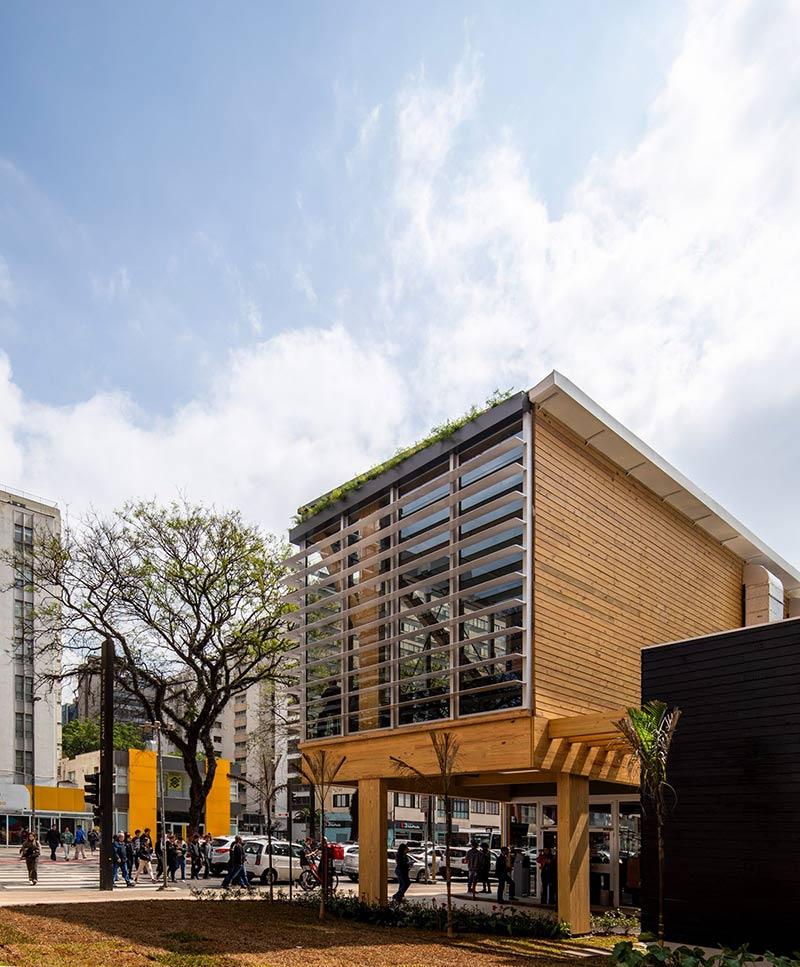
One major challenge is expected to be net-zero restructuring of the supply chains, which produce around 80 percent of their total emissions – the meat production alone sends their carbon emissions sky high. However, it will at least be possible to achieve net zero for the construction and operation of McDonald’s restaurants – and the first climate-neutral branch that opened recently in England is an initial step.
Text: Gertraud Gerst
Translation: Rosemary Bridger-Lippe
Photos: Maíra Acayaba
University enters the green building revolution
The Marga Klompé Building at Tilburg University is the first academic building in the Netherlands to be built out of wood. Insulation made from recycled denim jeans is part of the circular design by Powerhouse Company.
Marga Klompé (1912-1986) was the Netherlands’ first female government minister whose achievements included the Social Assistance Act (Algemene Bijstandswet), which was adopted in 1963. She was awarded an honorary doctorate by the then Catholic University of Tilburg in 1982, and now the new university building has been named after her in recognition of her work. Completed in 2023, the Marga Klompé Building offers around 1,000 self-study places for Tilburg University students. What’s more, they can spend time here without needing to worry about their carbon footprint, since the building is (nearly) energy neutral in day-to-day operations and its construction used minimum resources.
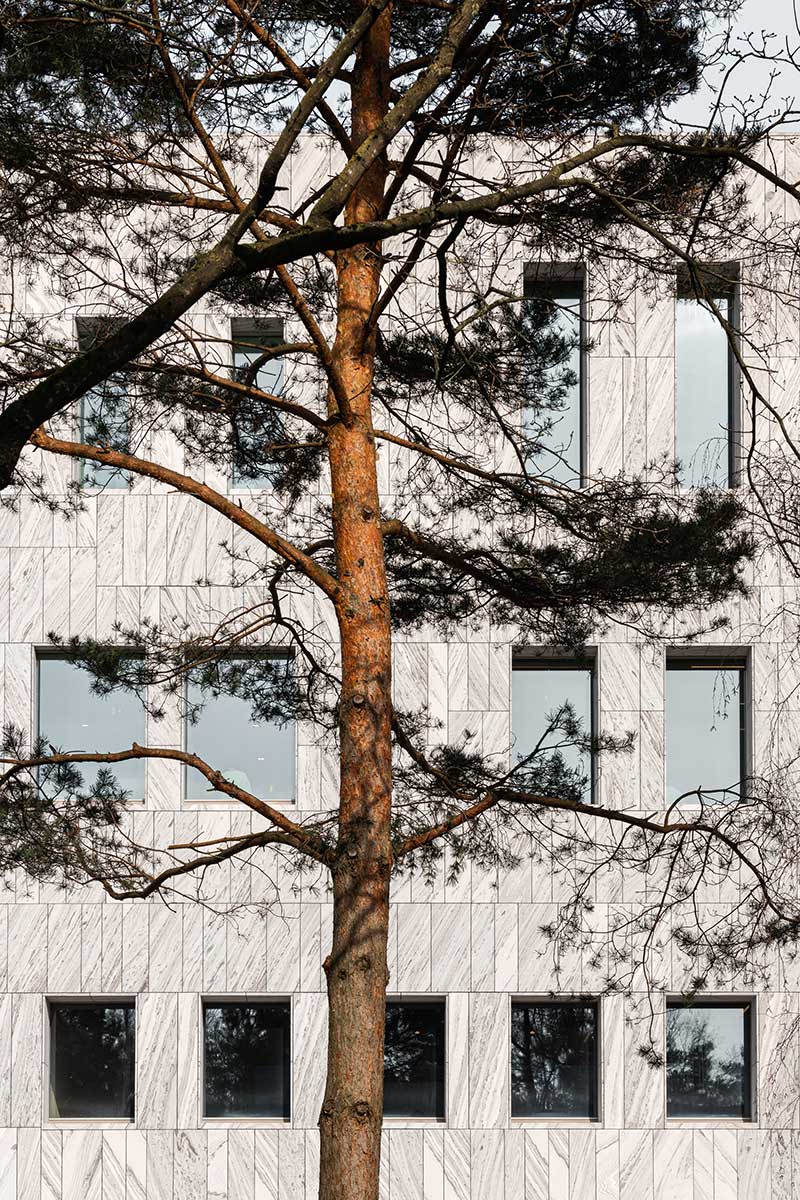
This sustainable approach is outlined in the project description by the architects responsible, Powerhouse Company, whose plans for the academic building were implemented in detail. Indeed, there is actually little difference between the photos of the completed project and the original visualizations that showed the intended design.
Lightweight timber construction
Nevertheless, several adaptations were necessary during the construction phase. In particular, the high acoustic demands for the building presented a special challenge in combination with the lightweight timber construction. “Pioneering is not easy, but we managed to keep the design and concept alive,” architect Janneke van der Velden explained in conversation with architecture online magazine Dezeen.
Pioneering is not easy, but we managed to keep the design and concept alive.
Janneke van der Velden, architect at Powerhouse Company
The choice of timber, as a renewable construction material, reflects the circular ambitions of the new university building. Wood is used not just for the basic structure, but also for all the walls, floors, stairs, frames and surfaces.
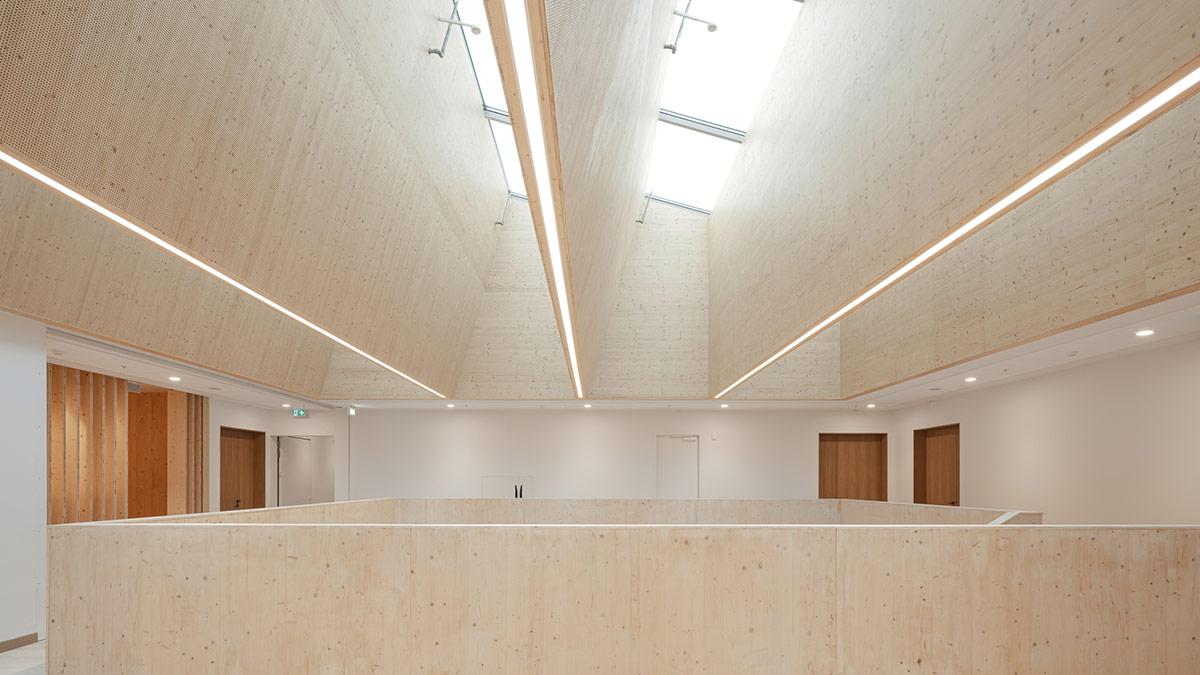
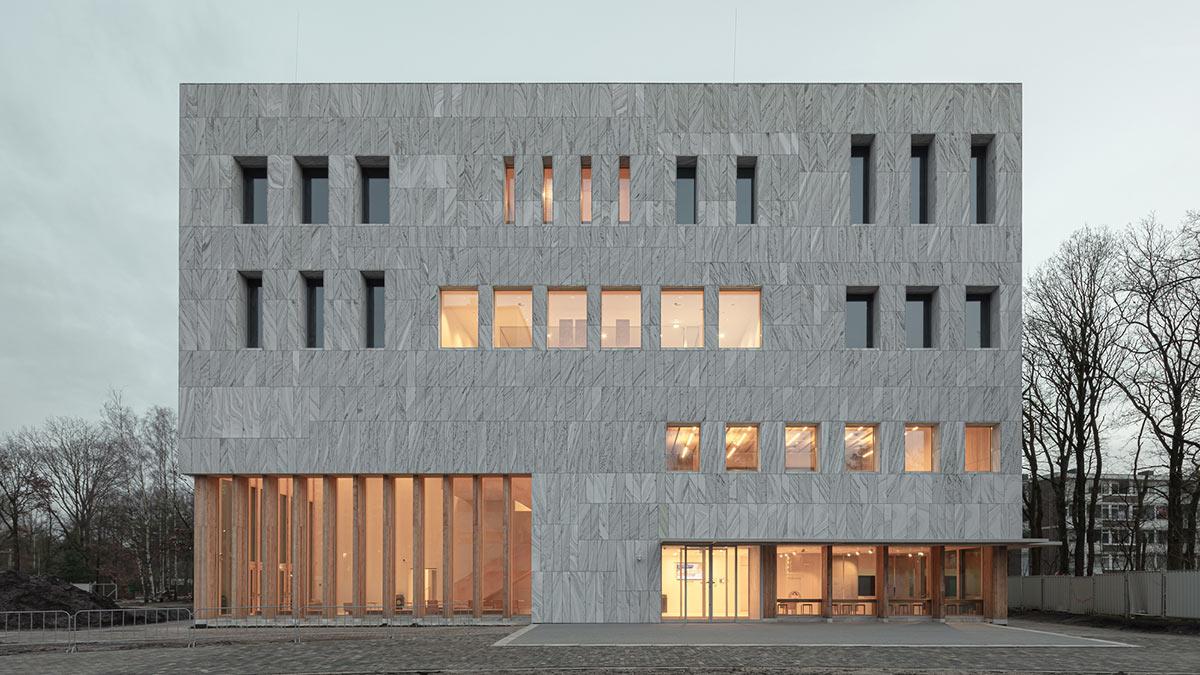
A lightweight construction using wooden ribbed floors enables large spans without affecting the room acoustics. “Wood is a very important circular component and has a very warm and welcoming appearance – it blends in very well with the trees that surround the building,” remarked van der Velden.
Recycled denim as insulation
As far as the sustainability of the building is concerned, the architects based their concept on the Trias Energetica strategy, which was developed at Delft University of Technology in the Netherlands. The highest priority of this principle is to use construction measures to reduce the energy needs of a building to a minimum.
The cotton insulation consisting of recycled denim jeans is sustainable and has proven to be an excellent way to improve the building’s acoustic comfort.
Powerhouse Company, architects
The concept envisages a smart use of natural resources, allowing the energy necessary for operations to be provided by renewable supplies. And in the event that fossil fuels are unavoidable, this energy will be used efficiently. It all sounds very logical.
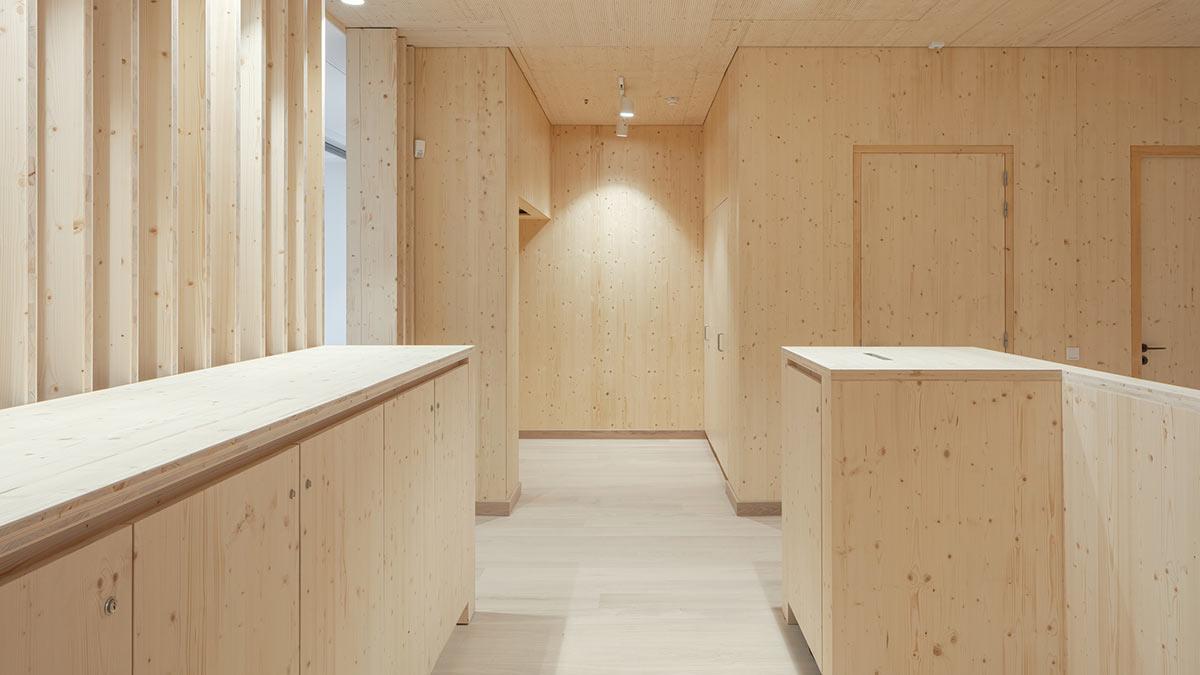
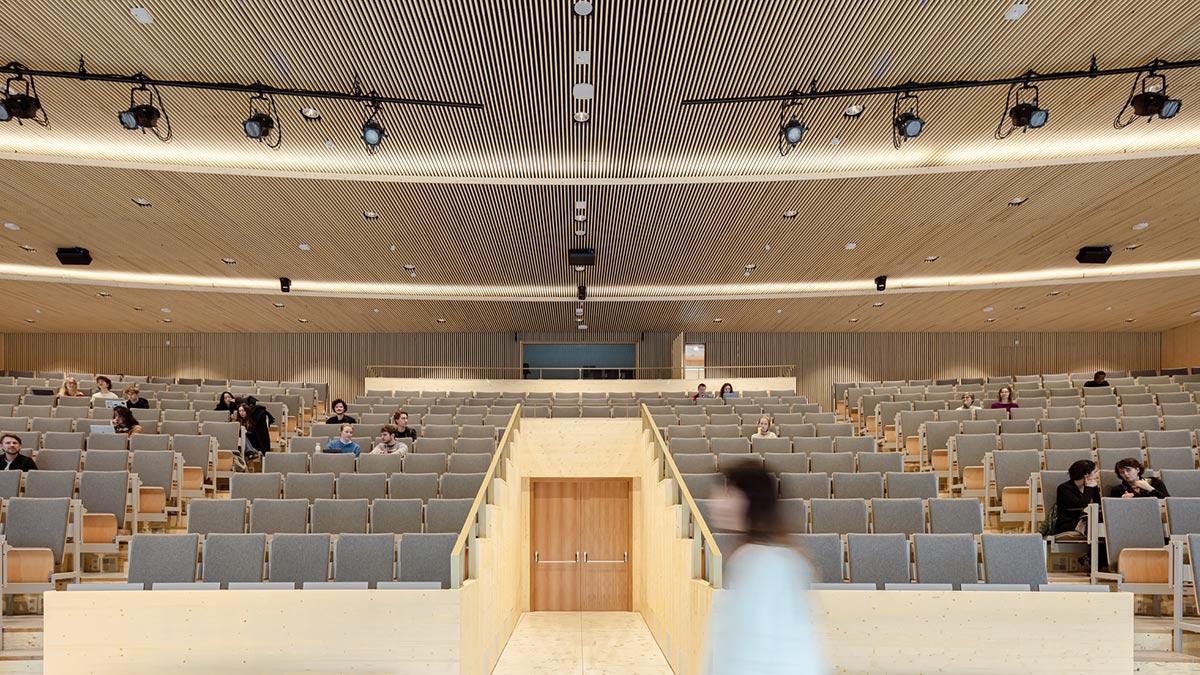
A functional landscape
Besides the importance of climate protection for today’s construction projects, another critical consideration is to include measures that protect against the negative consequences of climate change. While in earlier times, designing green spaces focused purely on aesthetic perspectives, nowadays these features usually meet other needs as well.
With this in mind, the landscape architects commissioned with this work, REDD, designed a concept for a resilient ecosystem that minimizes the risk of flooding. The surrounding area gently slopes away from the very edge of the Marga Klompé Building. A small wadi with planted wildflowers is not just an attractive sight, it also serves as an area where water can seep away in heavy rain. This stops the water draining directly into the sewer system and overloading the infrastructure.
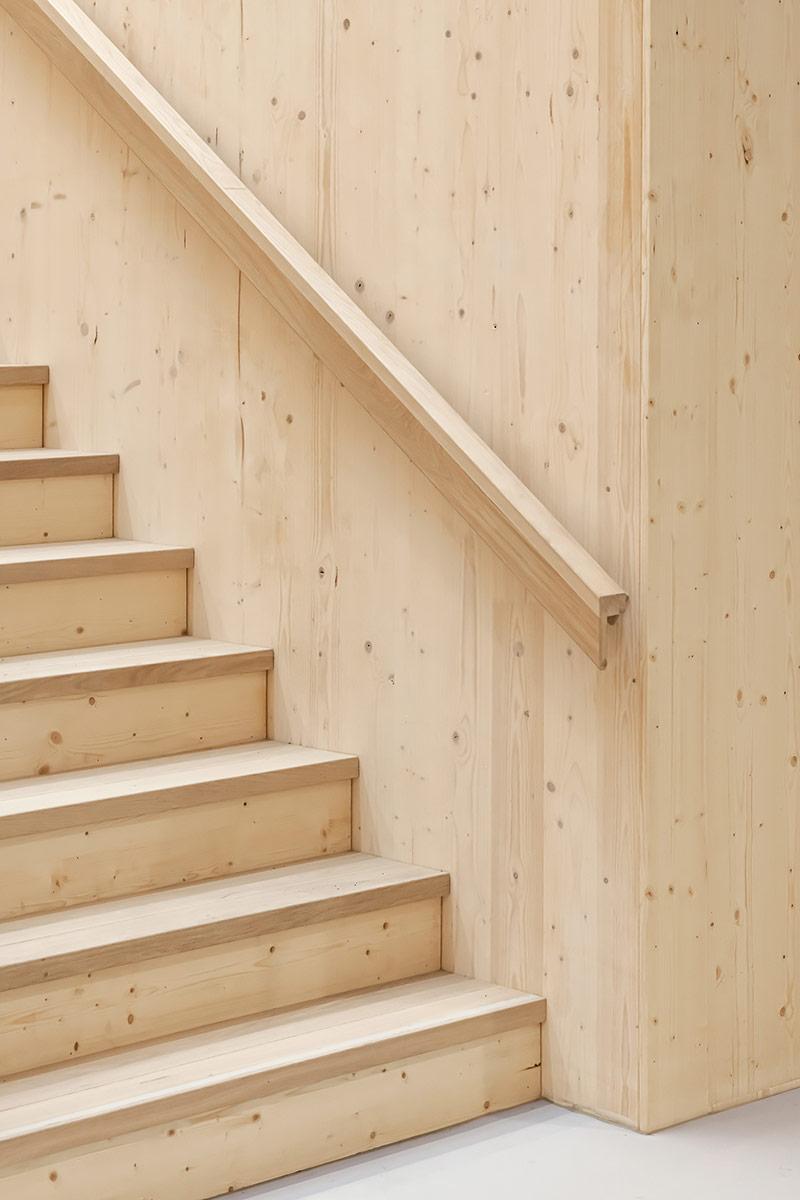
The choice of a timber construction with its virtually net zero, circular design is a clear sign of the commitment by Tilburg University to the green building revolution and climate reversal. Still, one claim in the architects’ description needs to be corrected – the Marga Klompé Building is not actually “the first college building in Europe to be entirely constructed from solid wood”. This was actually the Ilse Wallentin Haus at Vienna’s University of Natural Resources and Life Sciences (BOKU), a four-storey timber construction that opened back in 2020.
Text: Gertraud Gerst
Translation: Rosemary Bridger-Lippe
Photos: Sebastian van Damme
The woman behind Henning Larsen
CEO Mette Kynne Frandsen has worked for over 20 years to make Danish architectural firm Henning Larsen what it is today: a pioneer in creating sustainable yet iconic architecture around the world. She gave us an interview before leaving her position.
The company’s offices are located on the top three floors of a mid-century building on Copenhagen’s busy Vesterbrogade shopping street. From the layout of the office alone, it is clear that the cult of architect stardom has run its course. Mette Kynne Frandsen, CEO of Henning Larsen, is sitting at a desk in an open-plan space, directly in front of the atrium parapet. There is no fancy office with an executive chair. Not even her own allocated desk with family photos. Everything she needs for work is right here in the meeting room where the interview takes place: tablet, mobile phone and a glass of coffee.
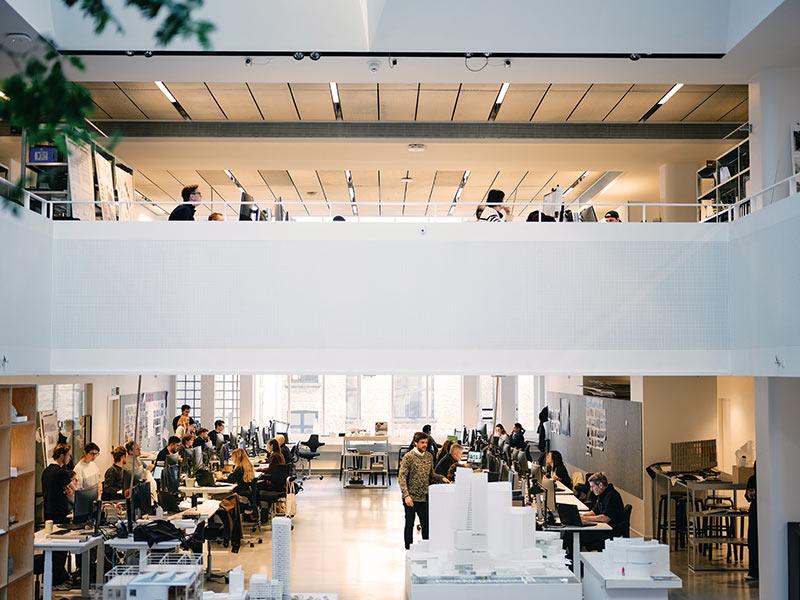
She recently celebrated 30 years with the company. “I’m not sure if that’s something to be proud of these days,” she jokes. The fact is that, with Frandsen at the helm, the company has become an international byword for a type of architecture that drives forward green innovations and regularly sweeps the board at award ceremonies. Company founder Henning Larsen (1925–2013) – who is primarily known for building The Royal Danish Opera in Copenhagen – personally handed her the reins of the company, allowing her to define its direction even during his lifetime.
As of the beginning of September, at the age of 63, she intends to take things a bit easier and hand over the management of the company. As one of Denmark’s most prominent managers, and as a woman in this position, she is an important female role model in an industry that is still dominated by men.
She spoke to us about biogenic building materials, the paradigm shift in architecture, and the good fortune to live in one of the world’s most progressive cities.
Even though more women have graduated in architecture than men for some time now, they are far less likely to be found in decision-making positions. As one of the most important managers in Denmark, you are living proof to the contrary. What were the decisive prerequisites and turning points in your career that led you there?
I have been with Henning Larsen for 30 years now. That’s quite a long time! For young people today, staying with the same company for 30 years might not be something to aspire to. But I didn’t plan it that way. When I started out, there were around 50 of us in the Copenhagen office. As well as working on competition designs, I started taking on more and more project management tasks. As I had studied architecture, I had a very solid technical background but didn’t know much about management.
So I suggested to Henning Larsen that I study for an MBA for two years and he welcomed the idea. When I had almost completed it, he came to me and said: “OK, Mette, now that you’ve had the training, you can take over the management of the company.” This unconditional support meant an awful lot to me. It was the basis for my whole development after that.
graduated from the School of Architecture at the Royal Danish Academy of Fine Arts in 1987. She joined Henning Larsen Architects in 1993 and moved into management in 1998. From 2003 onwards, she was in charge of the company in her capacity as CEO and was responsible for its strategic orientation. Under Mette Kynne Frandsen’s leadership, the company received the prestigious Mies van der Rohe Award for the Harpa Concert Hall in Reykjavík. She is on the board of a number of Danish organizations, including the Trade Council of Denmark. In 2019, she was presented with the Knight’s Cross by Queen Margarete II for her services to architecture.
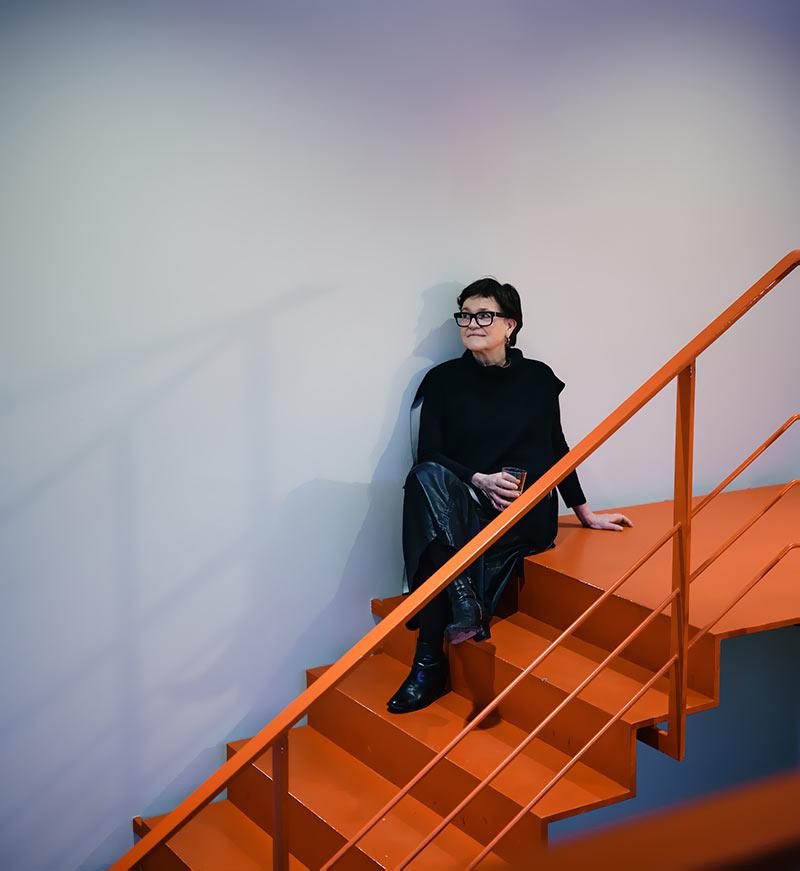
Mette Kynne Frandsen is one of the most influential women in contemporary architecture.
Were there role models for female managers back then?
To be honest, there weren’t many role models at the time, just over 20 years ago. But Henning Larsen was a role model for me in the way he worked as an architect, especially in the cultural sphere. As he wasn’t all that well versed in finance and personnel management, there was a space in the company that I could fill. On this basis, we developed a great working relationship and were able to set about implementing the changes that were planned for the company.
What changes were these?
At the time, Henning Larsen was approaching old age. This meant that we were planning a generation change and also wanted to get more partners on board. As well as this, we needed to realign our company’s culture, which until then had been shaped solely by Henning. How do you take a company that has been founded by just one very strong personality and steer it towards the future? It was perfectly clear to me that we need both women and men if we want to be successful in the long term. Today, the ratio of women to men in our company is 50:50, including at management level. It’s always important to have the right balance, but I think we have really strong female architects and leaders here at Henning Larsen.
I think we have really strong female architects and leaders here at Henning Larsen.
Mette Kynne Frandsen, CEO of Henning Larsen
What would you consider the greatest successes in your career?
Today, Henning Larsen is an international company with a broad positioning, and is foundation-owned. Rather than just managing international projects from our Copenhagen base, we have set up studios in other regions. We now have offices in New York, Singapore, Berlin, Munich, Oslo and Sydney. That means we are a global organization and a global community. I firmly believe that the diversity that comes from having as many different voices as possible outside Copenhagen as well is enormously important for design. 60% of our revenue today is generated from projects outside Scandinavia. And I am very proud of that.
We took another strategically important step four years ago when we became part of the Ramboll Group, a major engineering and consultancy company. Our shared vision is to create sustainable cities and buildings that answer the global challenges. We made this move because, even though we were active internationally, we were still too small to take on legal or financial experts in all these countries. This means that we are still active in architecture and urban planning under the Henning Larsen brand but, with Ramboll, we have a network that supports us in many areas as well. Here, we also benefit from our foundation model, where profit is invested back in the company. Our Innovation and Sustainability department has increased fivefold during this time, which is something that benefits all projects in many different ways. That really helped us to step up our innovation.
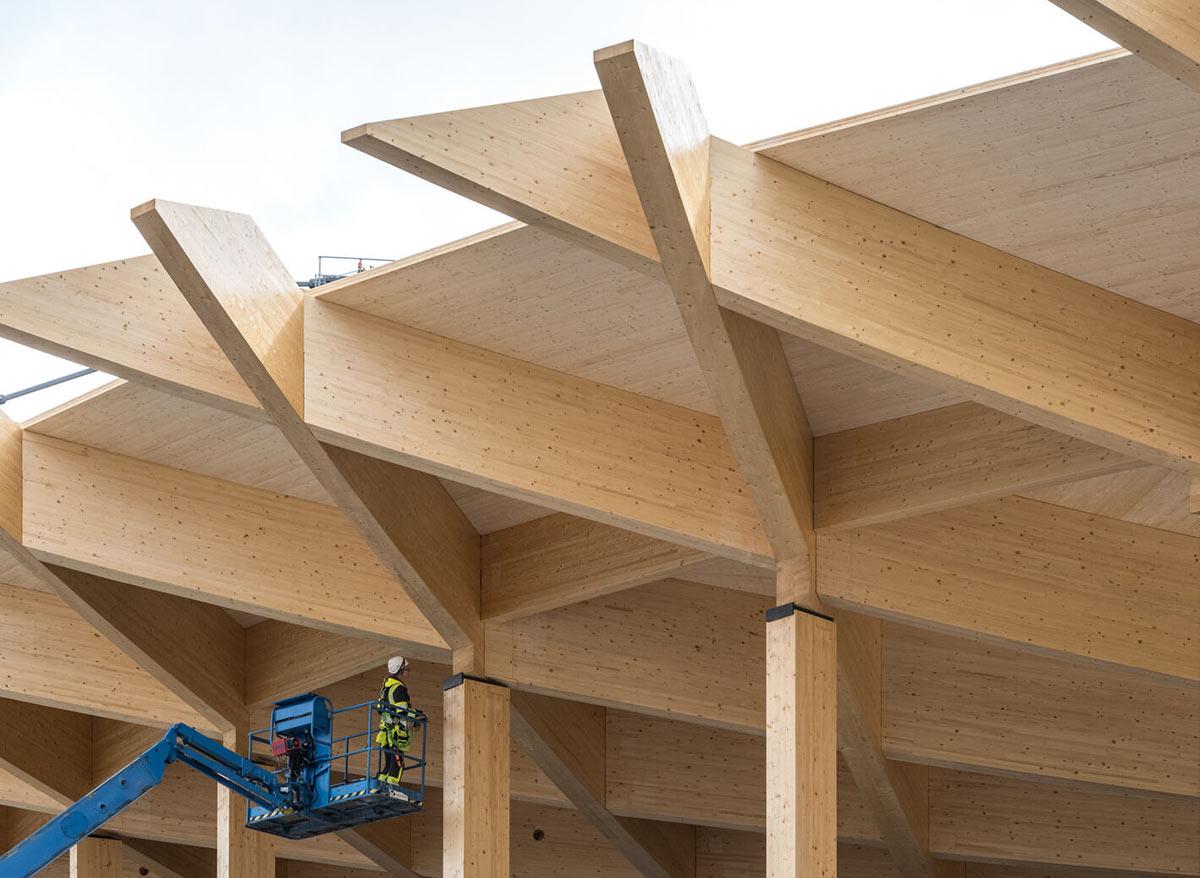
What developments do you envisage for Henning Larsen and architecture in general in the next ten years?
One of our goals is for Henning Larsen to grow as a global community and to become an even stronger partner in sustainability that advises and inspires its clients – regardless of where in the world we are working. Apart from that, we are currently in a transformation period due to the urgent need to address climate change. So in ten years from now, our designs will be very different – you can even see the changes happening now. We are moving away from being a company that used to be mainly interested in new-build projects and towards one that will focus more in future on working with existing buildings. And this really stimulates creativity.
Where exactly can these changes be seen?
A transformation in construction systems is beginning, and the use of biogenic building and insulation materials is starting to take off. Another change is the close collaboration between architects and landscape architects. This not only affects the way we design buildings but also has an impact on urban planning as a whole. In my position, I am seeing a growing awareness among politicians and clients about how important this collaboration is for all of our lives.
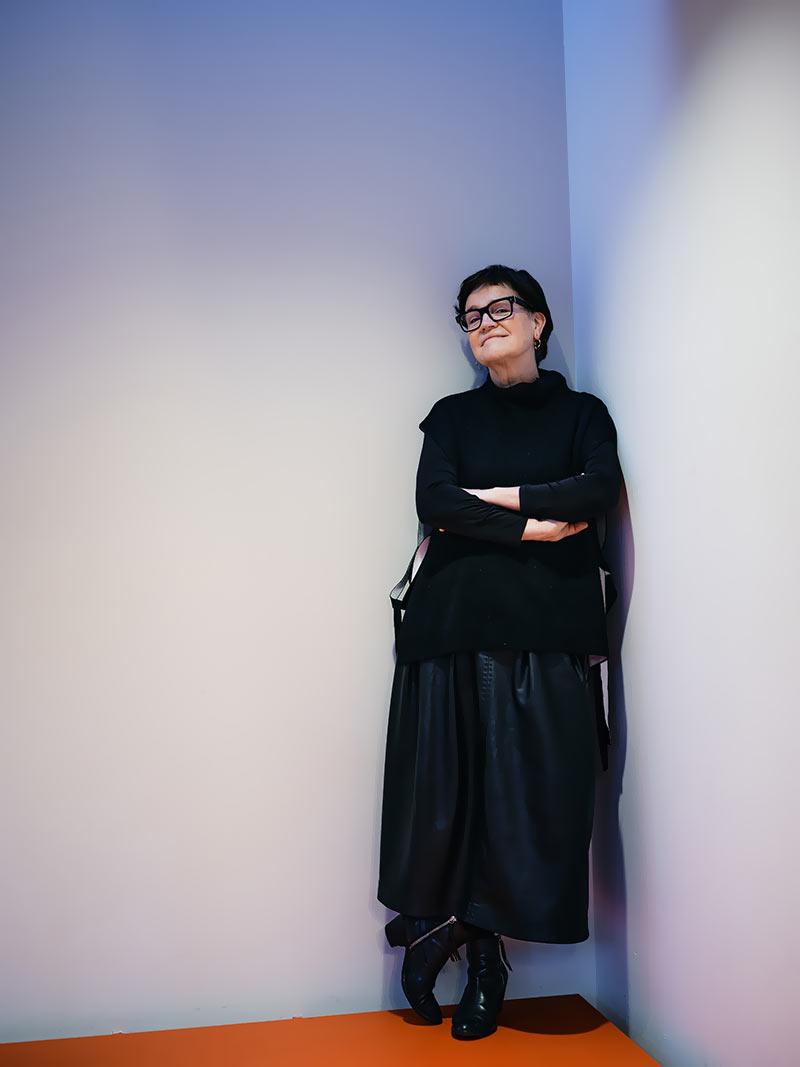
We are moving away from being a company that used to be mainly interested in new-build projects and towards one that will focus more in future on working with existing buildings.
Mette Kynne Frandsen, CEO of Henning Larsen
Many European cities were planned by men, which is reflected in their infrastructure, architecture and traffic management. Women, who still do the bulk of care work even today, usually have a different everyday routine than men – a fact that is not factored much into city planning. How does your office approach urban development projects these days?
As architects, it is important for us that city planning should include everyone. We have a research project called “Urban Minded” which considers how the design of urban spaces can contribute to the mental health and well-being of teenage girls. We conducted lots of interviews with young women and girls, asking questions such as: Where do you go at night in the city? How do you use your city? This project allowed us to obtain many very useful findings which can begin to address these issues, envisioning a future that prioritizes the well-being and empowerment of young women in our urban design.
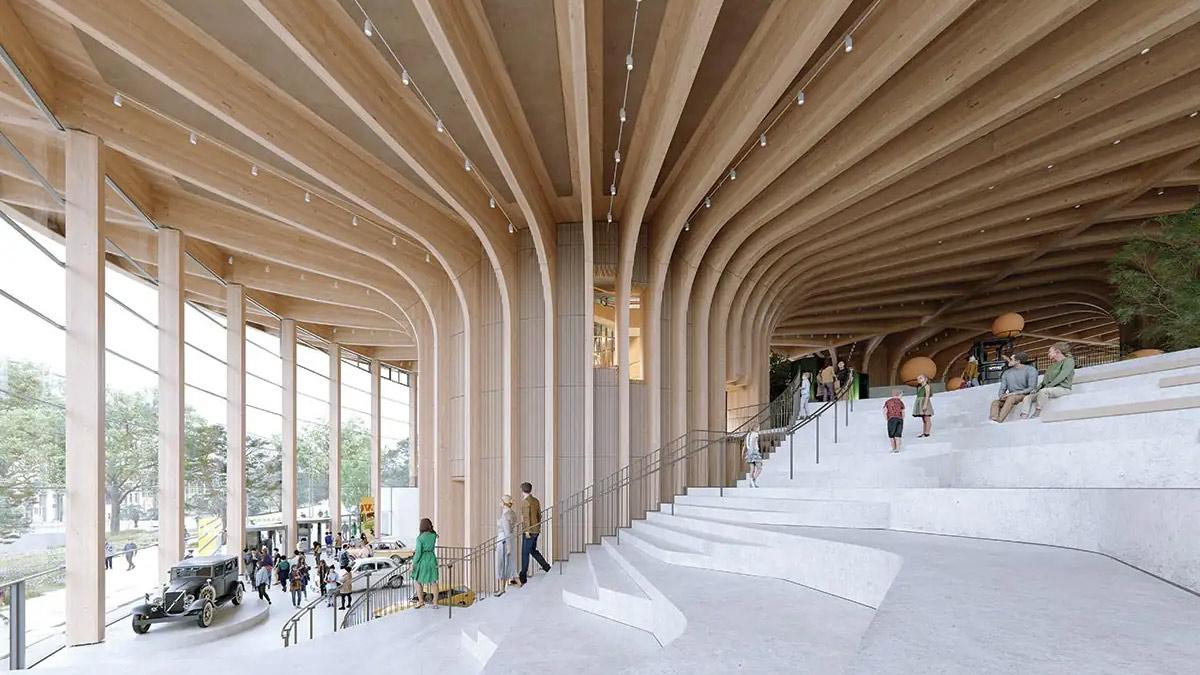
Copenhagen has become a model city when it comes to urban development. It has even given rise to the term “Copenhagenization”.
I think that in Denmark we have found very good solutions and have a lot of expertise in effective urban planning. In Copenhagen, politicians were also instrumental in driving forward the concept of a liveable city. In this way, we were able to inspire others and to put our well-tried solutions into practice in projects outside Denmark. Many cities are currently revising their mobility concepts. Needless to say, this is an enormous investment, but I think we will see a huge transformation in our cities in the next ten years.
I often travel to our global studios and can see the differences in the cities with my own eyes. Last week, I was in New York visiting our team, and I called my two daughters and said: “Do you know how lucky you are as young mothers in Denmark? You can take your children to kindergarten and easily bike to work.” In the US, thanks to differences in urban planning, it can be very difficult for women, and working in the architectural sector is no exception. Of course, we can’t change the whole system there, although I can try to provide as much support as possible for the female architects in our New York office.
Today, you often hear people using the terms “compact city” and “city of short distances” – a concept that feminist city planners were already advocating back in the 1970s. Can you give an example of an urban development project where this was used?
For example, our master plan for Downsview in Toronto is a huge project that is to be implemented over the next 50 years. Instead of planning cities with a business quarter and residential area, we are breaking up the area into local communities and neighbourhoods. Ten years ago, master plans were really about structures and mega-cities but today the focus is much more on people and community. With this project, there was a large-scale community engagement process beforehand, where people were able to get involved directly.
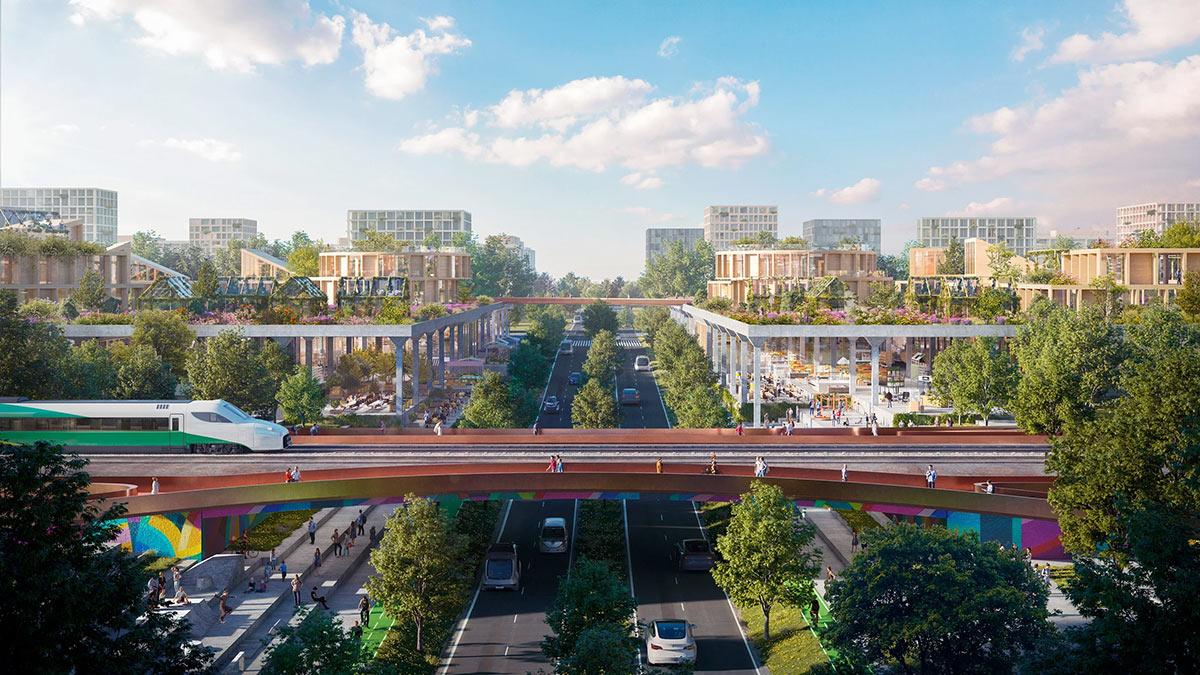
All of this input is reflected in the master plan. The infrastructure is set up to allow people to move about as easily and safely as possible within the neighbourhoods. The way that we work today – working from home to a greater extent – has also influenced urban planning.
What project are you particularly proud of at Henning Larsen?
Things have changed quite a bit in this regard over the years. Ten years ago, we were particularly proud of the iconic buildings like the Opera House. But if you were to go around the office today and ask people that question, you would find they are most proud of the small, innovative projects. For example, Feldballe School, which came about through a cooperation between philanthropic organization Realdania and a start-up that wanted to launch a façade element made of straw and timber. We implemented this project and succeeded in scaling up the biobased construction system. And now a logistics centre in the Netherlands – the largest anywhere in Europe – is going to be built in the same way as the little school in Denmark.
Ten years ago, we were particularly proud of the iconic buildings like the Opera House. Today, it is the small, innovative projects that make us most proud.
Mette Kynne Frandsen, CEO of Henning Larsen
From this project, you can also see what paradigm shift has already taken place. Five or ten years ago, we wouldn’t have dreamed of building logistics centres! But today we see there is a great sphere of influence here, where we can drive forward innovations and change things for the better.
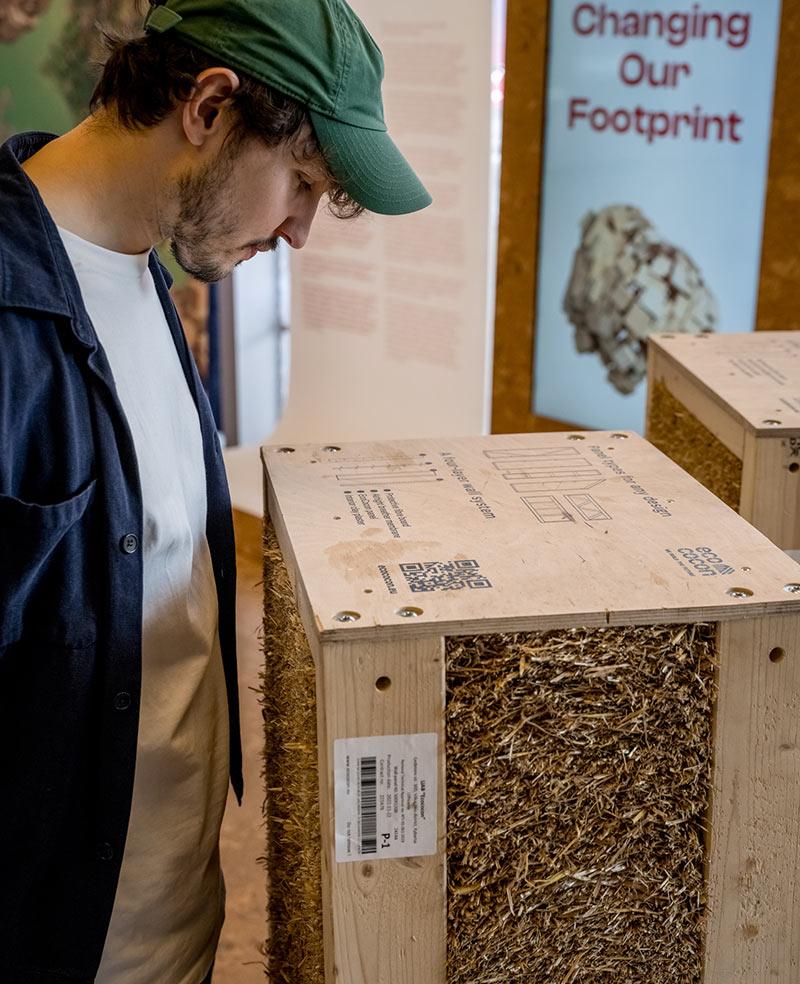
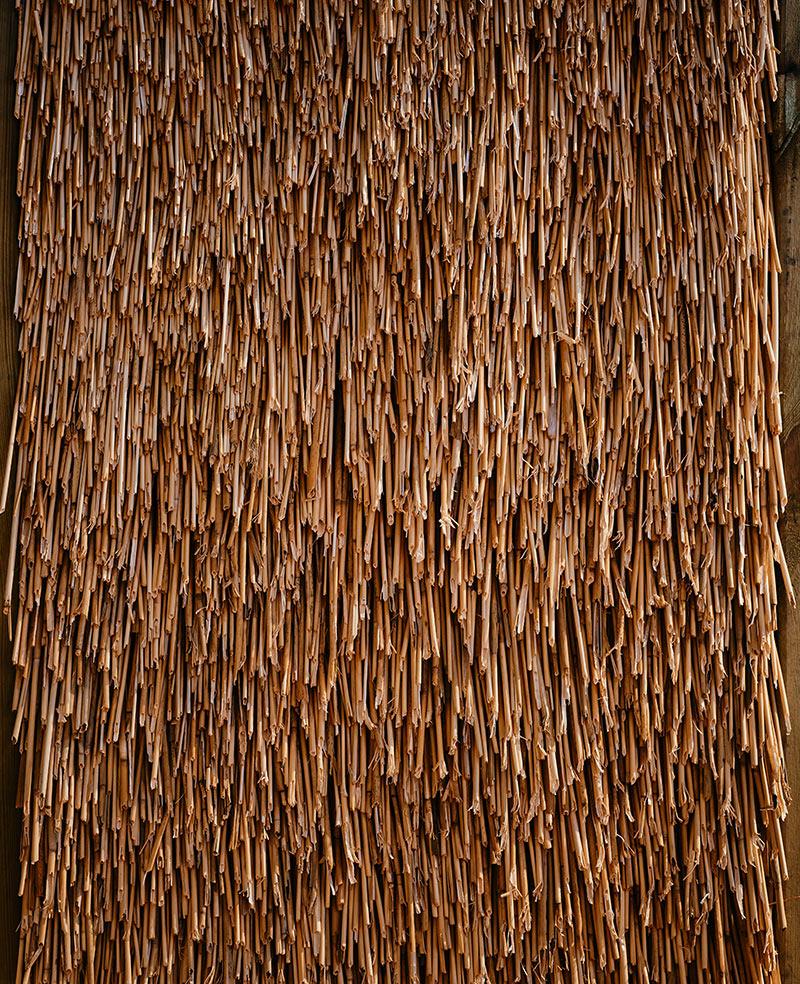
The Danish Architecture Centre recently hosted the Changing Our Footprint exhibition, where visitors could see and even touch a model of this timber and straw construction. How important is open-source thinking in your company?
As we all have the same goal – to have a positive influence on the future of our planet – sharing knowledge is enormously important. We can inspire and learn from one another. Some of our biggest competitors are now our best partners in certain areas. This is a development that I am very happy about. I get lots of calls from colleagues asking: “How did you do that? What were your learnings?” I’m just happy to share. The world is such a big place and the more we learn from each other the better.
But that’s also something that has changed – it wasn’t like that ten or twenty years ago.
Maybe it also has a little to do with the fact that there is a woman at the helm. Of course, we need competition as an incentive, but there are other values that are important too. I would like to see this openness continue at Henning Larsen in the future.
As we all have the same goal – to have a positive influence on the future of our planet – sharing knowledge is enormously important.
Mette Kynne Frandsen, CEO of Henning Larsen
According to a UN report, the building and real estate sector is generating record levels of greenhouse gases, accounting for almost 40% of global carbon dioxide emissions. What responsibility do architects have today?
The sense of responsibility in the industry has increased enormously. Especially among the new generation of young architects who are very idealistic and question lots of things – including whether we should get involved in new-build projects at all. The young generation wants to use architecture to help shape the future of the world in a positive way.
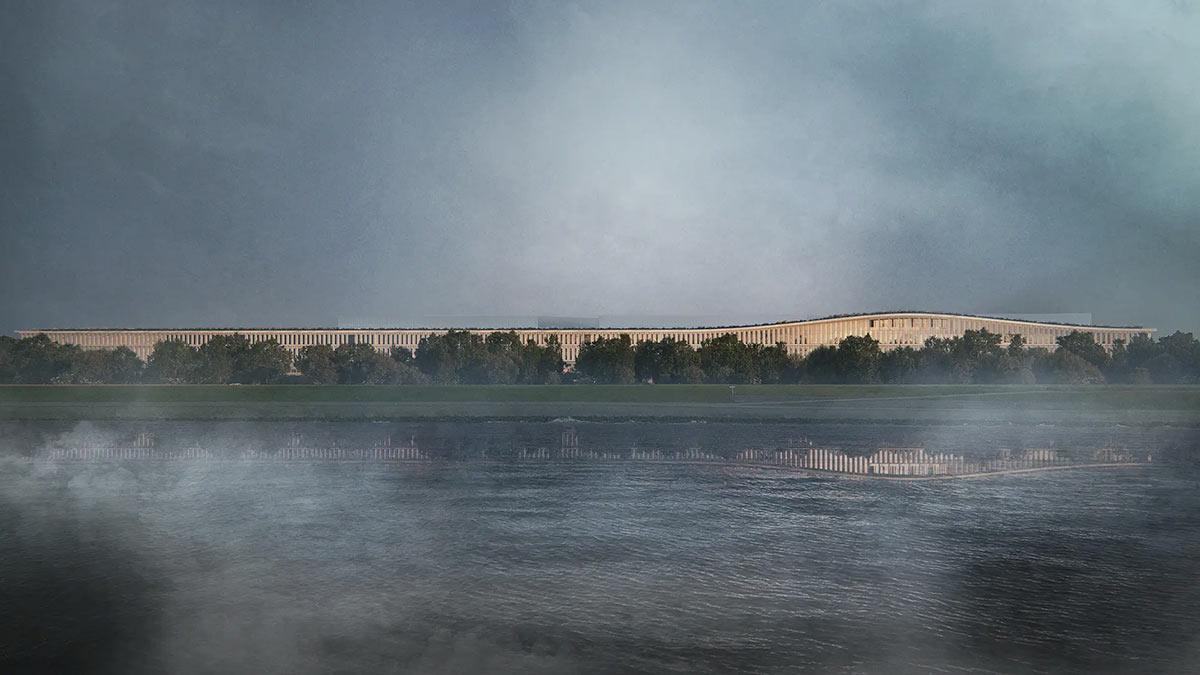
Our economic system needs to break free of the “take-make-waste” principle and be more regenerative. We are creatures of habit and changing processes in our complex, interconnected world calls for time that we don’t have. How could the necessary changes be accelerated?
By setting good examples – and there are plenty of these. We need to step up our communication in this regard. At the same time, we are seeing growing interest in sustainable solutions among our clients because they are required to report on their performance in social and ecological sustainability. Some project briefs that we receive these days call for us to retain and adapt as much of the existing building as possible. That goes beyond saving grey energy, as preserving historical building fabric also endows a sense of identity.
These days, projects shouldn’t be evaluated based on construction costs alone, they should also factor in the carbon footprint, which we work out for each project. And then you can compare both the costs and the emissions of the various options – from new build to circular project.
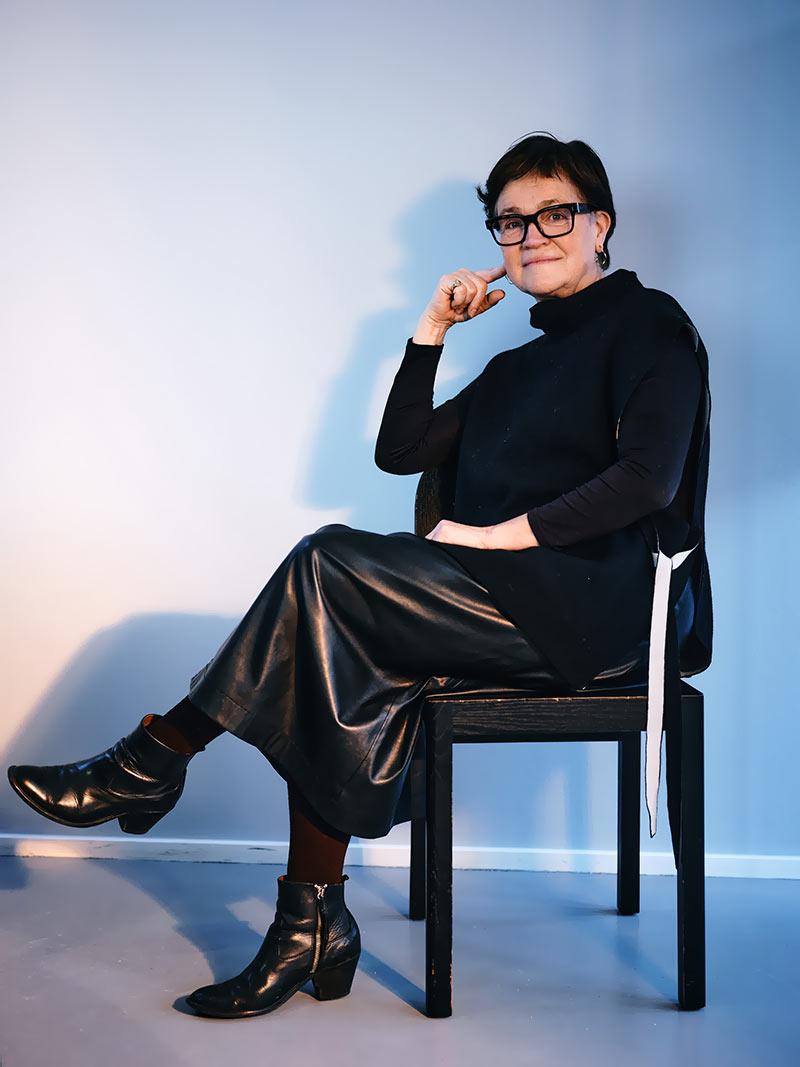
The climate crisis has shifted the focus back to very old building materials and methods, namely wood, straw and earth. Is technology no longer the be-all and end-all? Or is low-tech the new high-tech?
I think it’s a combination of both. In the past, we poured lots of concrete into buildings to meet the structural requirements – these days, we can use parametric design to optimize the amount of concrete we use. Right now, the price of recycled bricks has escalated because there is a severe shortage. With biobased materials, there is no end of smart innovations and there is also great interest from investors who recognize the potential they offer. I think it will be important to strike a healthy balance between construction materials in future.
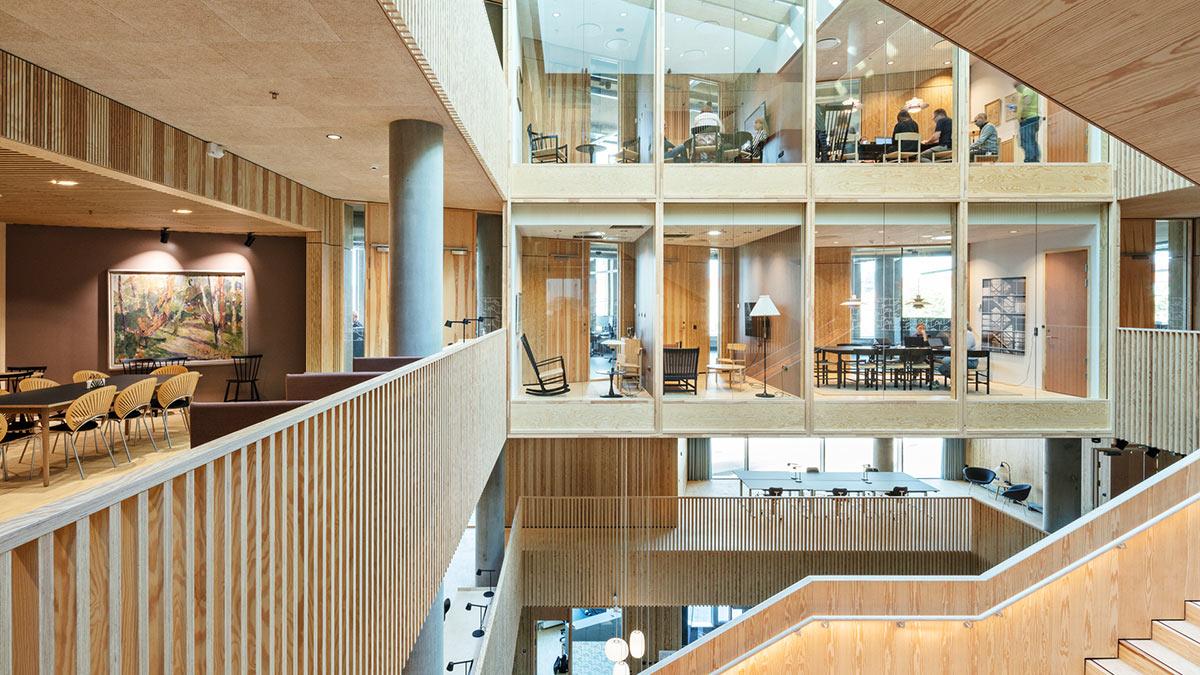
To date, there has often seemed to be two separate categories for buildings; they were either sustainable or iconic. Henning Larsen regularly succeeds in combining the two. How do you manage that?
For a start, timber construction is suddenly opening up whole new design opportunities and freedom – exploring these has been enormously inspiring for the architects. On the other hand, you need the latest digital tools for these forms. Without these, projects like World of Volvo would never have been possible. The great success of this project is also due in no small part to the collaboration between our designers, digital experts and the timber construction engineers and producers.
Timber construction is suddenly opening up whole new design opportunities and freedom – exploring these has been enormously inspiring for the architects.
Mette Kynne Frandsen, CEO of Henning Larsen
As it happens, I was visiting the facilities of Austrian company WIEHAG when the huge, curved glulam beams were being produced for World of Volvo. That was really impressive.
When I was training as an architect, visiting construction sites was an important part of the process. How is a building actually constructed? What exactly does a carpenter do? We had a lot of hands-on knowledge. And this knowledge fell by the wayside a little with the rise of digital design. However, the new construction materials are once again arousing the interest of architects in production processes. I think it’s very healthy to have this connection.
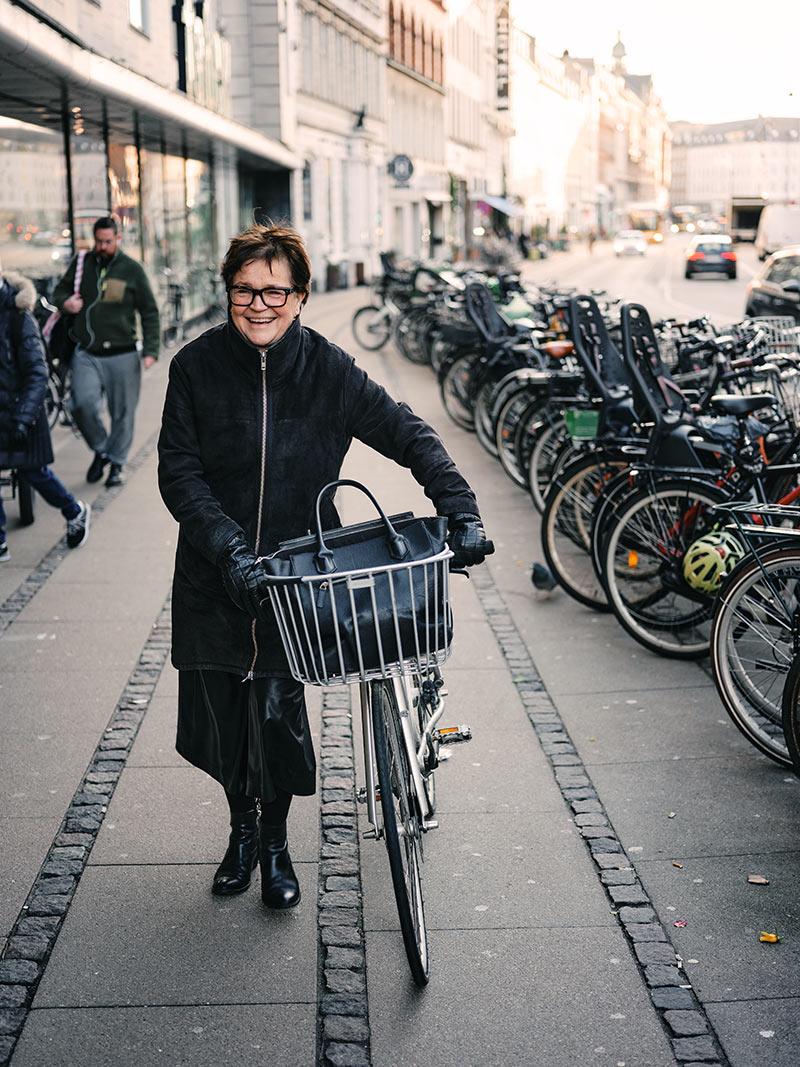
Copenhagen, the world’s most bicycle-friendly capital: After the interview, Frandsen hops on her silver sports bike and heads off to her next appointment.
Just like the emergence of the “form follows function” principle at the end of the 19th century, we are experiencing a kind of new departure again today. What could be seen as its guiding principle?
I think it’s always good for form to follow function and wouldn’t interfere with that. But the way in which we use the areas and assign functions is something that we will have to take a closer look at in future. How many square metres can each person claim for themselves? How can we ensure that those areas that we don’t need every day can be shared? Those are questions that are always relevant for urban development. For example, you don’t need a guest room in your house if there is a communal guest house in your neighbourhood. Lots of new housing models are currently being built based on co-housing. I think we will need to optimize our current high square metre consumption.
If you were choosing a field of study today, would you opt for architecture again?
I think about this sometimes. Yes, I would study architecture again. I think architecture has never been as exciting as it is right now.
Interview: Gertraud Gerst
Photos: Philipp Horak, Laurą Stamer, Rasmus Hjortshoj
Visualizations: Henning Larsen
Affordable living space made with timber
Climate change and social issues are closely intertwined, and climate-friendly timber construction is often still classed as a luxury segment. The timber housing project Seestadt Aspern in Vienna is an award-winning example of social housing construction, and also an Instagram hotspot.
The climate crisis and global warming are making life progressively more difficult in our urban spaces. Higher levels of soil sealing – measured in the amount of asphalt, concrete, steel and glass used – are known to create larger urban heat islands. And tropical nights are now frequent in many large central European cities, with the temperature remaining above 20 °C. The ever more problematic climate in cities also reveals a social divide, as illuminated by the following questions: Who lives in the densely built-up areas? Who has access to green space and areas where people can rest and recuperate?
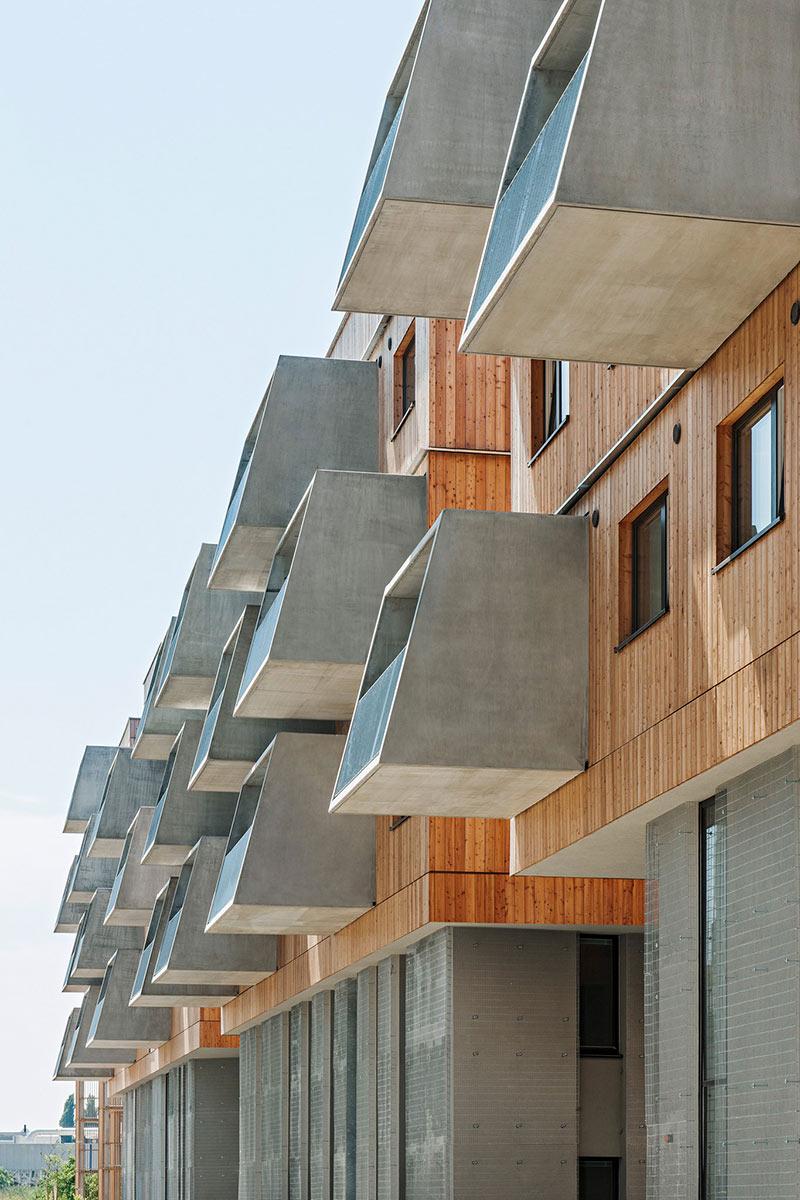
The city of Vienna has historically played a pioneering role in municipal housing construction. And recent years have seen the Danube metropolis increasingly show its support for wood as a climate-friendly building material. In eastern Austria, a region traditionally characterized by minerals, individual building sites are starting to be dedicated to large timber developments. One project – which has won multiple awards – has been developed on building site D12 in the young Seestadt Aspern quarter, commissioned by non-profit building cooperative EBG.
Social housing with added value
This area of urban expansion is one of the largest in Europe, and includes the 84-metre tower HoHo Wien which is literally a lighthouse project of modern timber construction. The D12 housing complex is located not far away, in the south-eastern part of this new urban area. The Viennese architecture firm responsible for the project, Querkraft, describes it as “social housing with added value”. Querkraft teamed up with architects Berger+Parkkinen to design the sustainable multi-storey residential construction.
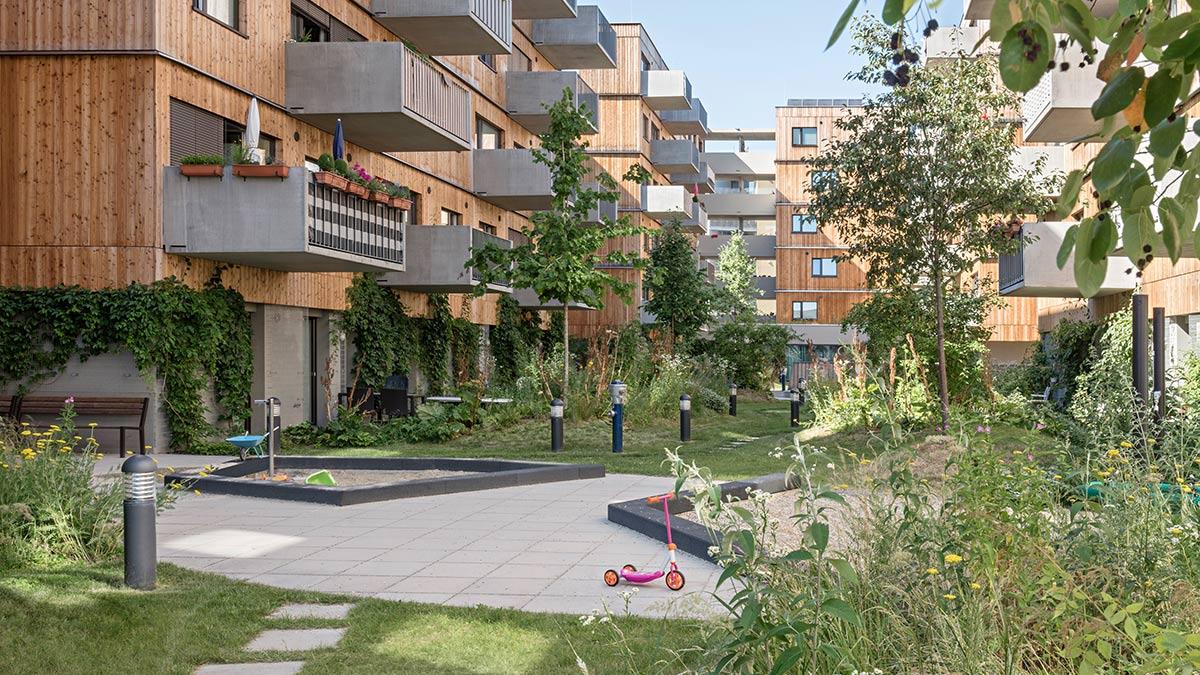
Instead of the perimeter development style commonly used, the team of architects opted for an open structure with seven buildings in three rows, linked to each other via walkways. “A varied spatial experience is created by the sequence of light-flooded stairwells, interior corridors and open walkways with docked community terraces.” The aim of these public spaces and pathways is to promote a sense of community and communication among the residents.
Wood is one of the most intelligent building materials imaginable – renewable, decomposable when recycled – it also has haptic qualities.
Querkraft, architects
The characteristic “comb” structure has even more advantages, according to the architects: “The serial, linear basic structure offers great flexibility in the arrangement of the most diverse types of flats and thus enables a good mix of residents.”
Letting off steam in the Canyon
Residents can find naturalistic recreational spaces in the lush green courtyards, which also help to improve the urban microclimate. The private, prefabricated concrete balconies deliberately extend into the centre of the courtyard and overlook the organic landscape featuring hilly lawns, trees and bushes. Pathways are limited, allowing nature and residents to find peace and quiet here.
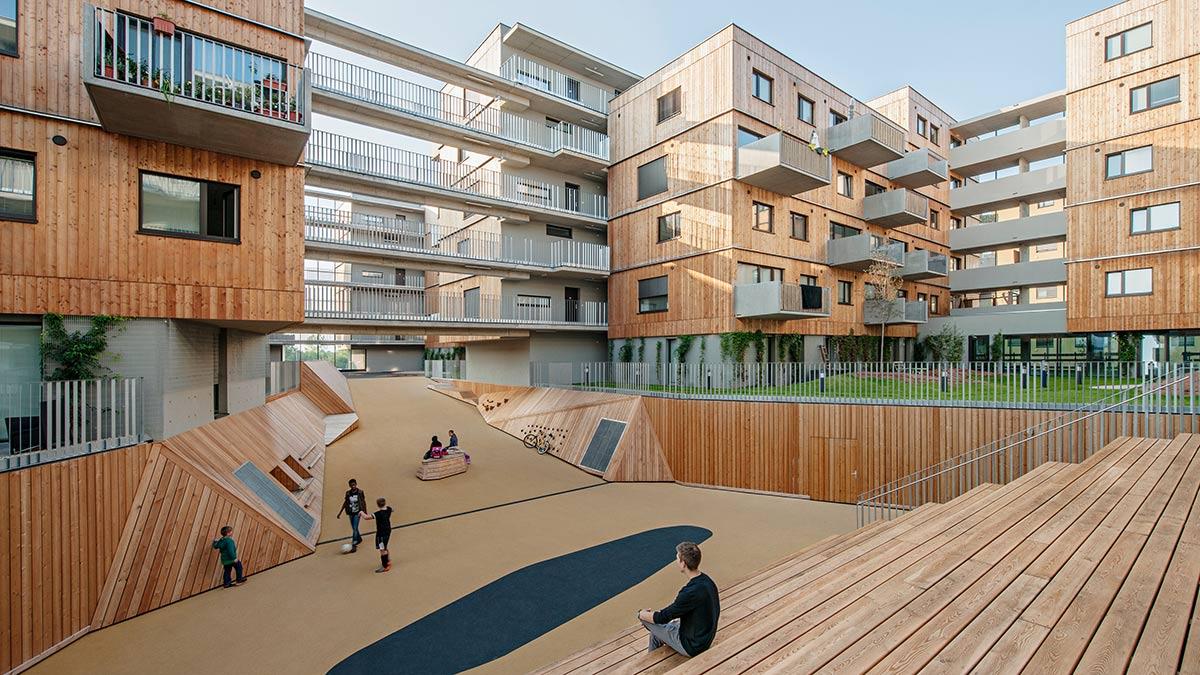
The “active zone” in this housing complex is found in the Canyon, an award-winning meeting place and playground for children and teens. Slanting walls, steps for seating, reclining areas and alcoves with wooden panelling are on offer in this activity area. Its space is ideal for children of all ages to play on their bikes and skateboards.
Austria’s largest wooden building envelope
The complex features a total of 213 flats and eight shops built according to a hybrid timber-concrete design. On a reinforced concrete skeleton with minimized supporting structure, highly insulated timber frame components are used. These were entirely prefabricated using local wood at the Weissenseer Compact Building Factory in Carinthia, as were the walls of the flats and the partition walls, including prepared installations. According to the Carinthia-based modular construction specialist, the housing complex in Aspern is Austria’s largest wooden building envelope.
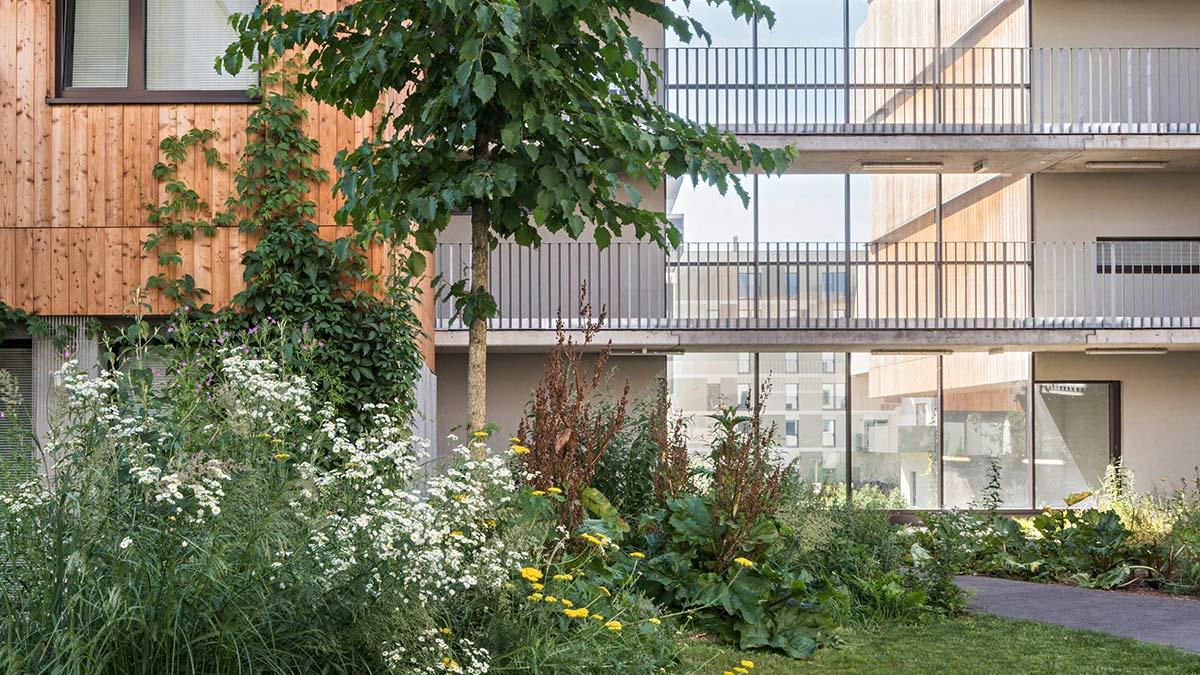
This resource-saving, timber hybrid construction method not only protects the environment and surroundings by shortening the construction time but also creates “lasting flexibility in the floor plan arrangement”. Wood is visible as a building material on the façades in the form of larch panelling. “Wood is one of the most intelligent building materials imaginable – renewable, decomposable when recycled – it also has haptic qualities. In contrast to fully insulated façades, wood is a material that consciously ages, turns grey and also creates a sense of identity in an urban context,” the architects explain.
Research into renewable energies
As far as sustainability of the building operation is concerned, the complex is part of a large-scale research project on renewable energies in connection with intelligent control systems. A combination of ventilation system with heat recovery, geothermal energy, photovoltaics, solar thermal energy and a heat pump provides the site with energy. The data supplied from this comprehensive monitoring project should deliver valuable information.
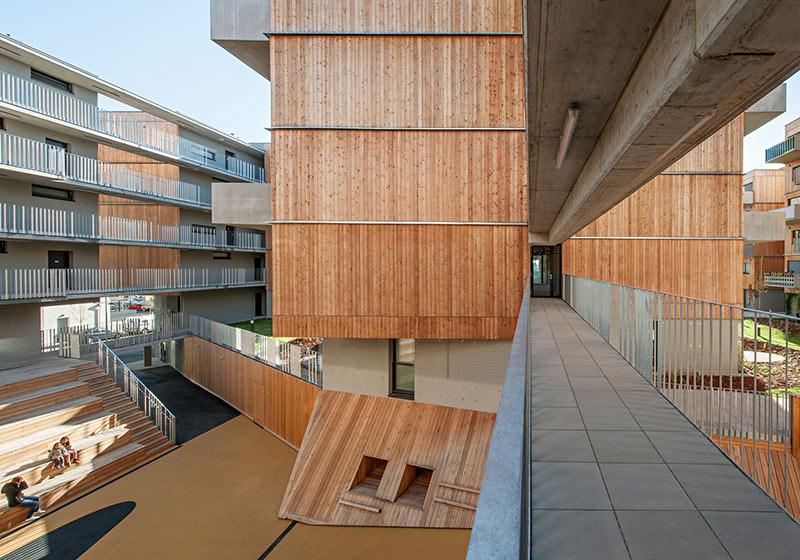
The fact that the wooden residential building in Seestadt Aspern has become a popular Instagram hotspot is a sign of its success. An abundance of wood and the cleverly conceived outdoor spaces for all ages create a high level of identification with the architecture.
To sum up, the architects say: “With its varied development situation and the ecological choice of materials for the façade, the D12 residential complex is something special in Seestadt Aspern.”
Text: Gertraud Gerst
Translation: Rosemary Bridger-Lippe
Photos: Hertha Hurnaus, Berger+Parkkinen Architekten, Querkraft Architekten
On track for transformation
Industrial wastelands need new strategies to present workable options for re-use. The architects at Smartvoll are experts in this kind of development. One of their designs is an ecosystem for the former railway depot in Amstetten, Lower Austria, as living space for plants, animals and people.
In the Industrial Revolution, railways played a trailblazing role. Trains were able to transport goods and raw materials in large quantities, which in turn enabled mass production. Consequently, historic railway buildings bear witness to the culture of days gone by and create a sense of identity. The former railway depot near Amstetten train station in Lower Austria is a case in point.
Trains and locomotives were shunted along the 22 sets of tracks here in times past. But the site gradually fell into disrepair with the dawn of digitalization and automation. After a successful interim phase as a concert location, the premises were earmarked for an innovative campus that connects work, education, art, living and leisure. The Vienna-based architects at Smartvoll – who are specialists in adaptive re-use – submitted a competition entry for redevelopment of the site, with sustainable thinking that combines a host of different aspects.
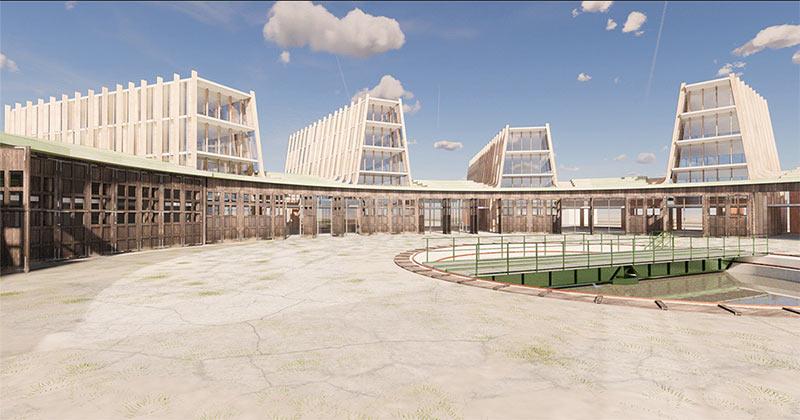
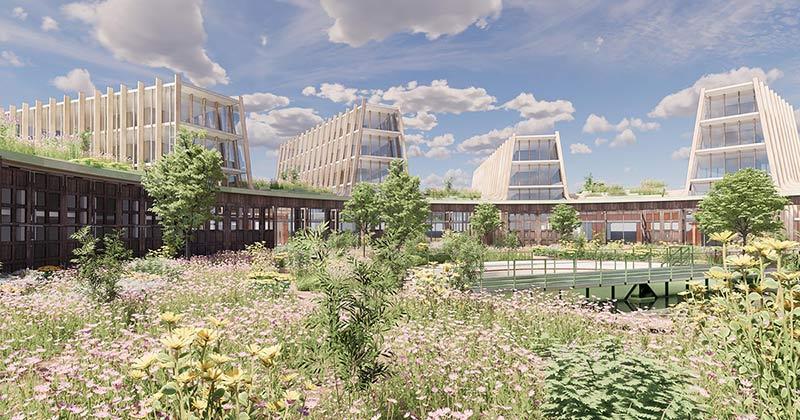
A case for preservation
Essentially, the architects’ key concern was to preserve the existing buildings to the greatest extent possible and integrate them into the new concept. Two fundamental considerations were behind this approach: On the one hand, the historic flair of the former Amstetten railway depot creates a unique atmosphere that they wanted to retain, as Dimitar Gamizov from Smartvoll Architects explains: “Especially in a district that will be characterized almost exclusively by new buildings, the charm of the existing and the patina is an atmospheric main asset.”
Especially in a district that will be characterized almost exclusively by new buildings, the charm of the existing and the patina is an atmospheric main asset.
Dimitar Gamizov, Smartvoll Architects
And on the other, preserving existing buildings also brings tangible ecological benefits owing to their significant volume of embodied energy. This latter term refers to the entire amount of energy used (and emissions produced) in connection with the construction process – from raw materials extraction and the production of building materials through to transport and building construction.
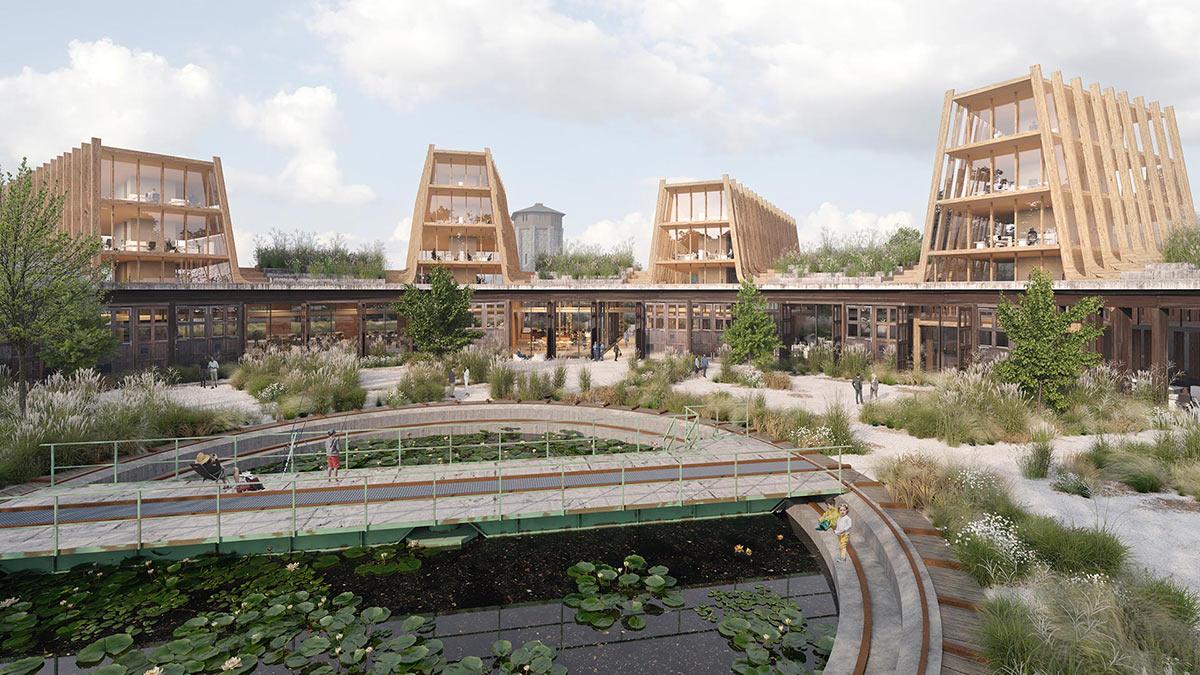
When a building is demolished, this primary energy is lost and a new production sequence begins. This in turn uses more energy and creates emissions. Considering that the production of construction materials causes 11 percent of global CO2 emissions, this is clearly the key lever for making construction climate-friendly. In other words, materials and structures need to remain in the cycle for as long as possible in future.
Ecological vs. financial value
Unfortunately, demolition and new builds are still cheaper and easier than preserving existing buildings. This was also one of the reasons why the design by Smartvoll landed in third place. The jury statement reads: “The expense involved in preserving the existing buildings does not seem to make financial sense, in consideration of the viability and fire protection.”
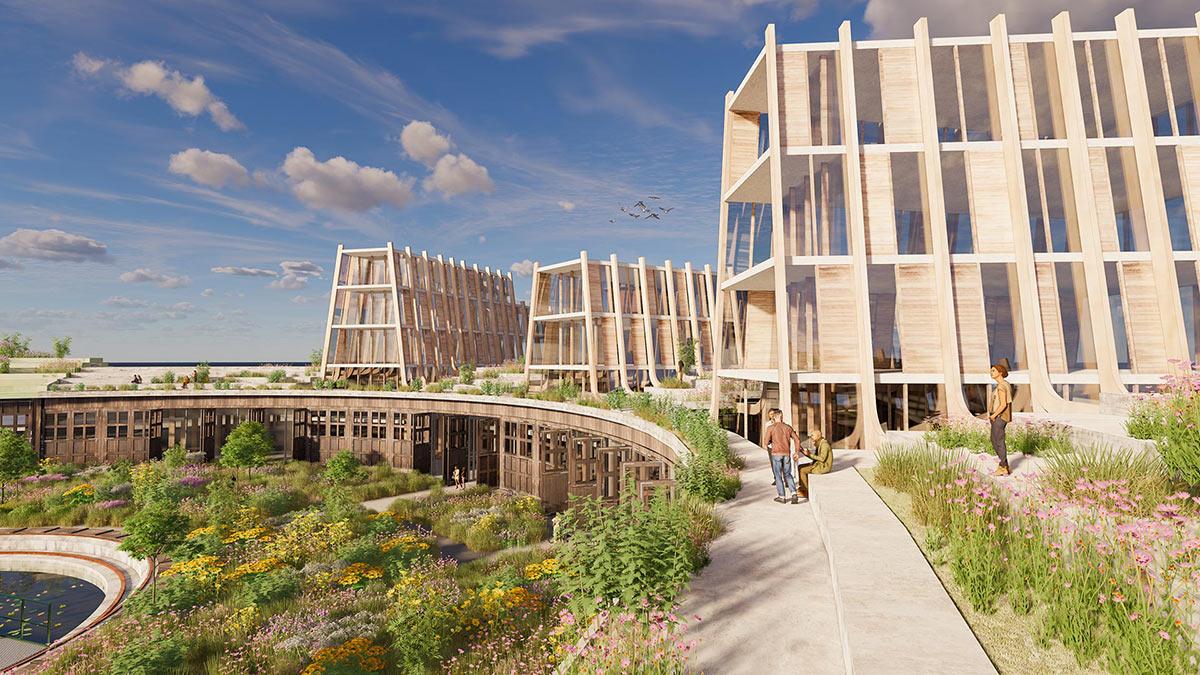
Even though this particular project was not chosen, it is nevertheless a highly impressive example of how industrial wastelands can be cleverly adapted and densification enabled using climate-friendly timber constructions. To this end, the architects added five volumes that appear to “grow” out of the former workshops underneath, which curve around the depot turntable. These new “implants” are carefully spaced and dimensioned to create a dialogue with the existing buildings and avoid any sense of overpowering.
Untamed nature instead of manicured lawns
“The project is therefore not about dogmatic preservation of substance, but about the precise selection of existing qualities,” explains Gamizov. For example, due to unsuitability of the old roof for re-use, the design instead envisages a new one with a garden accessed from the offices. He continues: “In the end, both parts – the new building and the existing structure – together offer more qualities than one part alone ever could.”
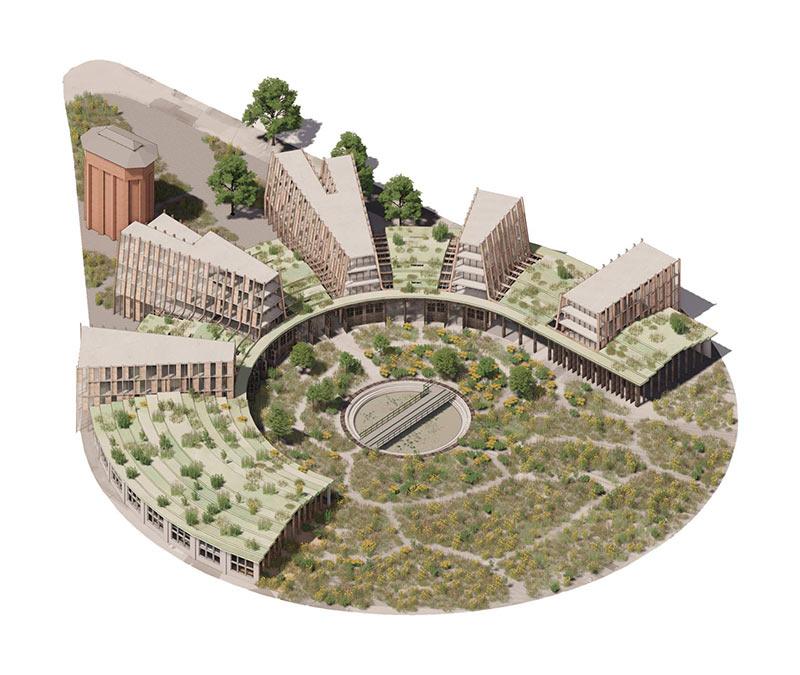
In the end, both parts – the new building and the existing structure – together offer more qualities than one part alone ever could.
Dimitar Gamizov, Smartvoll Architects
Over the years, nature gradually reclaimed the circular space in the middle of the wasteland. It is a process that is continued in the Smartvoll design. Instead of manicured lawns and overly regulated green space, the architects prefer an intentionally untamed mixture of trees and low planting, which prepares the neighbourhood “for a hotter future”.
Where trains were once turned in the middle of the depot, a biotope creates its own microclimate. And the surrounding unsealed green space helps rainwater to be collected and stored. As the architects explain: “We see the city as a collaborative ecosystem of plants, animals and people that can only function well in synergy.”
Text: Gertraud Gerst
Translation: Rosemary Bridger-Lippe
Visualizations: Tomak Vitalii & smartvoll
When the school bell rings
Its roof looks like three pyramids atop a space of celebratory grandeur, a wooden construction reminiscent of timber-framed buildings. This is precisely what the architects at Maccreanor Lavington had in mind for the new dining hall at Ibstock Place School.
Long, dreary corridors with the same classroom design behind every door. A feeling of tension throughout the building. This kind of scene will be familiar to many from their childhood days. While the vast majority of educational institutions cast their architectural and pedagogical shadow even today, modern architecture in schools is introducing new approaches to everyday life in education. New concepts for content and spatial design are emerging at the interface between teaching and architecture, renegotiated on equal terms by all involved. For architects, clients, pupils and staff alike, the aim is quite clear: the school of tomorrow will be an inspiring place.
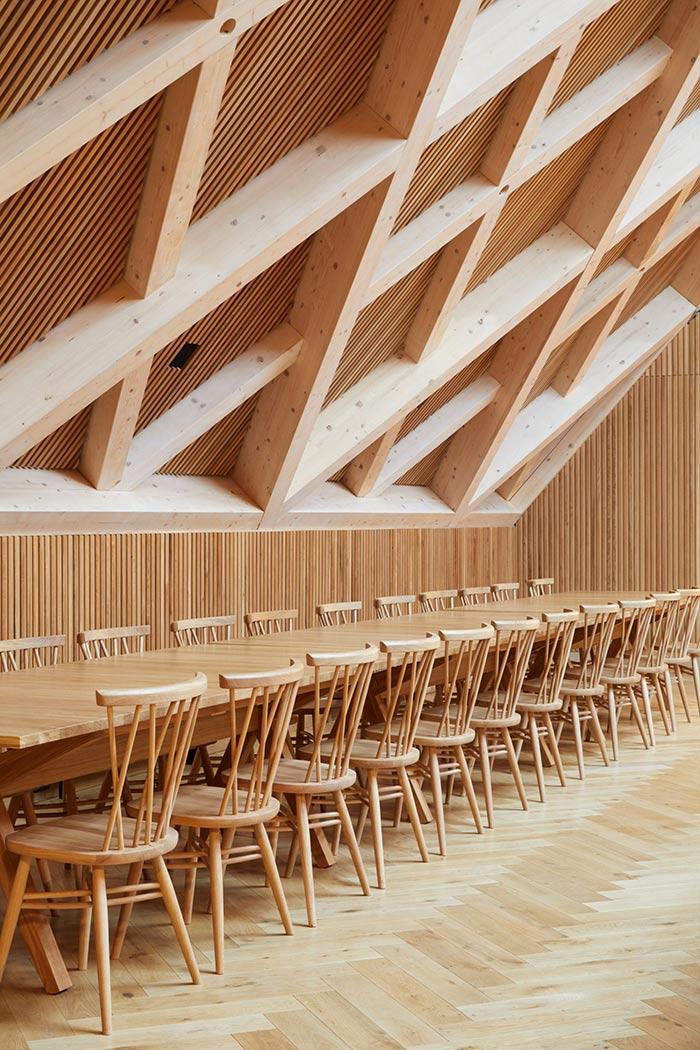
Our brief was to create a calm, quiet and enjoyable space.
This view was shared by British architects Maccreanor Lavington when they drew up their design for the new refectory at Ibstock Place School. In the meantime, the trio of structures developed by them have been completed and now form the east-facing edge of the property at this independent school in Roehampton, a district in south-west London. With its brick facade and pyramid-shaped roof, it draws upon its context of the adjoining historic Edwardian main house.
Dining hall with celebratory brilliance
Inside the new ensemble of buildings, there is a feeling of celebration that is usually foreign to this kind of dining hall. The structure of this timber construction extends across the endlessly long rows of tables and reaches an impressive room height of 12 metres. Latticed glulam beams form a vaulted mesh that is decorative while serving a specific purpose. Rectangular glazed lanterns open up the three volumes at the top and bathe the dining tables below in natural daylight.
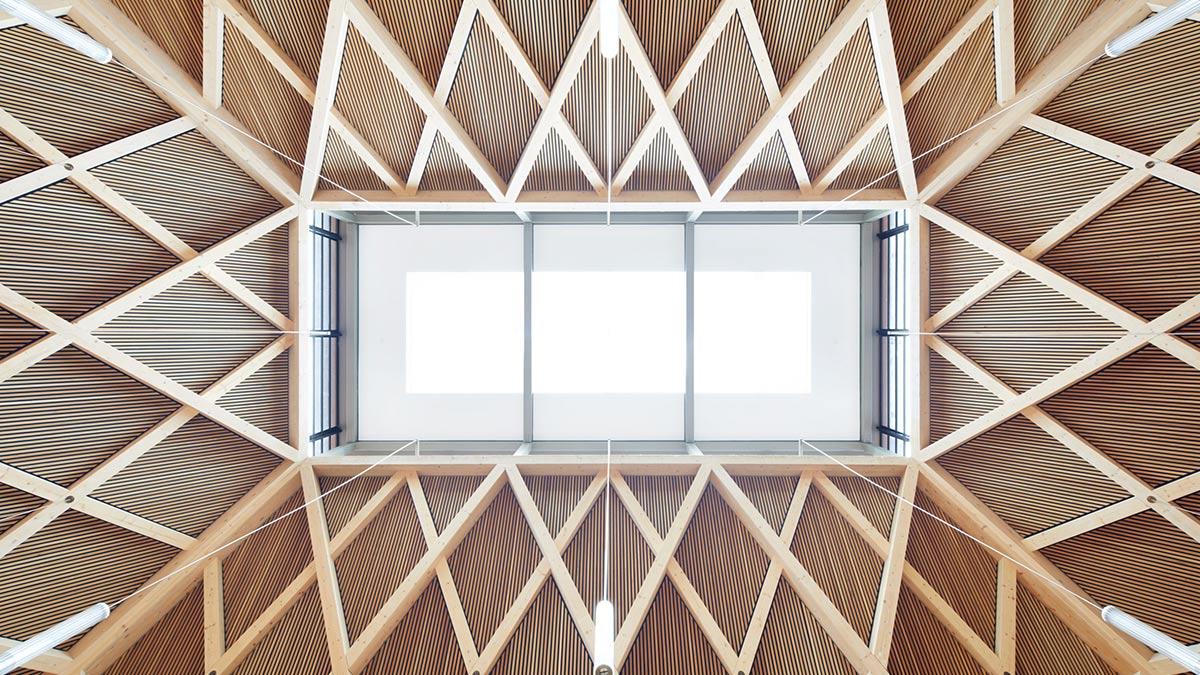
The architects describe their point of departure for the project: “We recognized the importance of school lunchtimes in supporting the emotional and social development of pupils, and wanted to create a building that is uplifting and celebratory. Our brief was to create a calm, quiet and enjoyable space for its users.”
Wooden panels absorb sound
With over 1,200 pupils who appear here to eat every day when the school bell rings at Ibstock Place School, this is probably easier said than done. To enable them to talk to their neighbours even when the hall is full, the architects used sound-absorbing surfaces. “The striking lattice structure of the vaulted ceilings frames inset panels of oak, designed to incorporate acoustic absorption to soften the background clatter of dining,” the architecture studio explains.
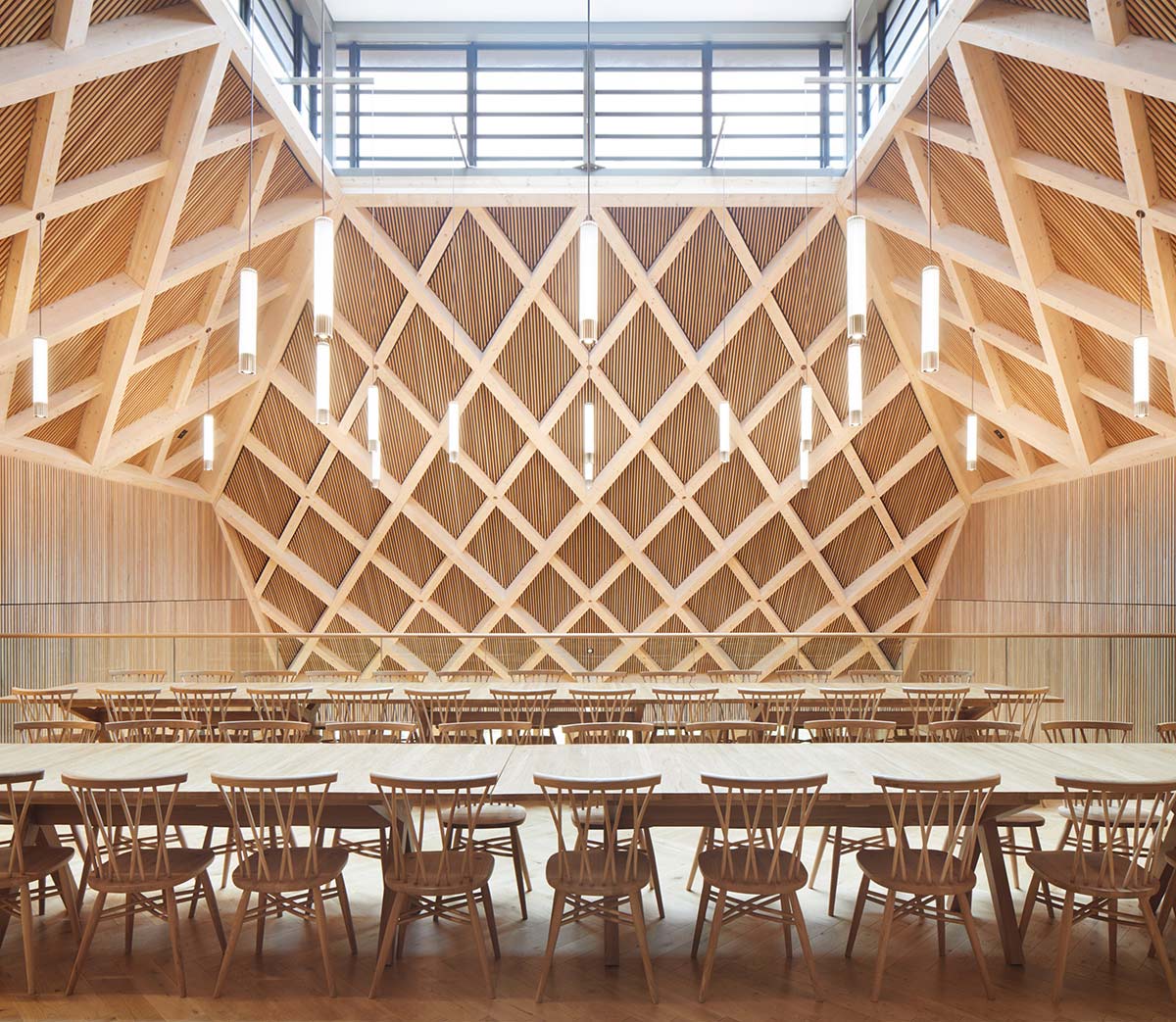
The form of the building is designed to moderate the internal environment without air conditioning.
Thomas Ormerod, architect at Maccreanor Lavington
The restrained material palette also helps to calm the atmosphere. Amid the swathe of different cream-coloured timber surfaces, the architects set individual accents in bronze. Door handles, handrails and light fittings create an upmarket contrast with the monochrome interior. “Our aim was to create a building of timeless quality,” says the architect responsible for the project, Thomas Ormerod.
Sustainable shape and material
The striking shape of the individual volumes not only evokes a certain festiveness, it also serves an important function, as the architects explain: “The form of the building is designed to moderate the internal environment without air conditioning.”
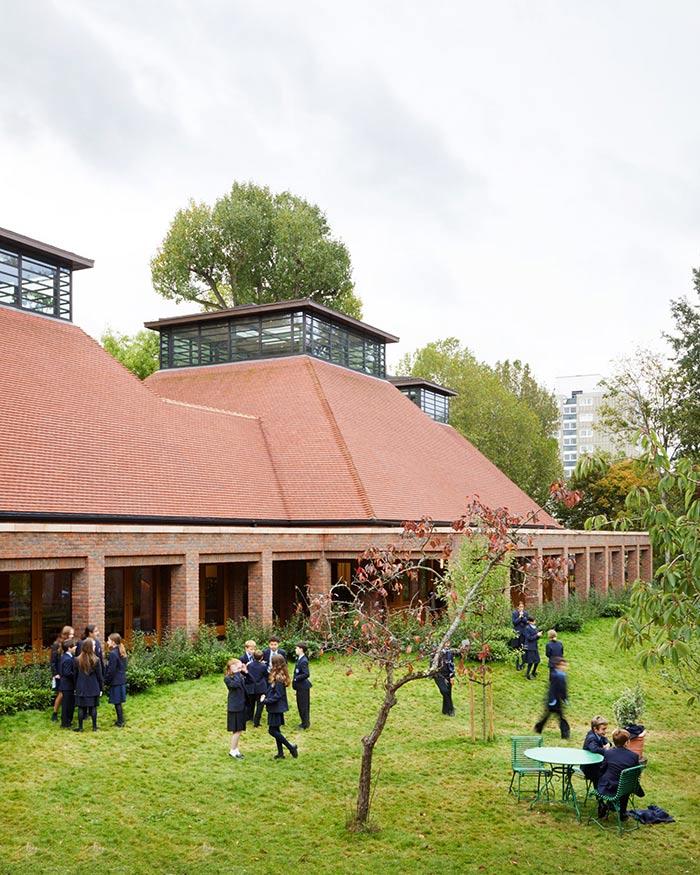
The glazed lanterns on the top of the roof act like a chimney that draws the warm, stale air out of the building via louvre windows. This is a clever, low-tech solution that works with the climate-friendly timber construction to avoid further fuelling the flames of climate change.
Compared to conventional building methods, timber construction projects have many different advantages, as Ormerod emphasizes: “The benefits of using glulam, apart from its beauty, were that the structure could be prefabricated and finished off-site.”
Text: Gertraud Gerst
Translation: Rosemary Bridger-Lippe
Photos: Jack Hobhouse
A church that stores carbon
As the first church to be built in Copenhagen for 30 years, it may well become an icon. Ørestad Church is a sculptural timber construction designed by Henning Larsen. A kind of “Church 2.0”, it is also a modern community centre that reaches out to everybody regardless of their belief.
Imagine a woodland scene, with trees standing closely together. In a glade, the light filters through the high treetops and casts a pattern on the ground below. It is an interplay of light and shadow that moves across the space as the day passes. This is the bright, uplifting feeling that the architects wanted to create with their design for the new Ørestad Church in Copenhagen. Rather than constructing a majestic building with a harsh exterior, the resulting experience is instead entirely organic and inviting. “The design concept reflects a modern understanding of spirituality. Instead of heavy stone, like in traditional churches, we are using wood,” explains Nina la Cour Sell, design director at Henning Larsen.
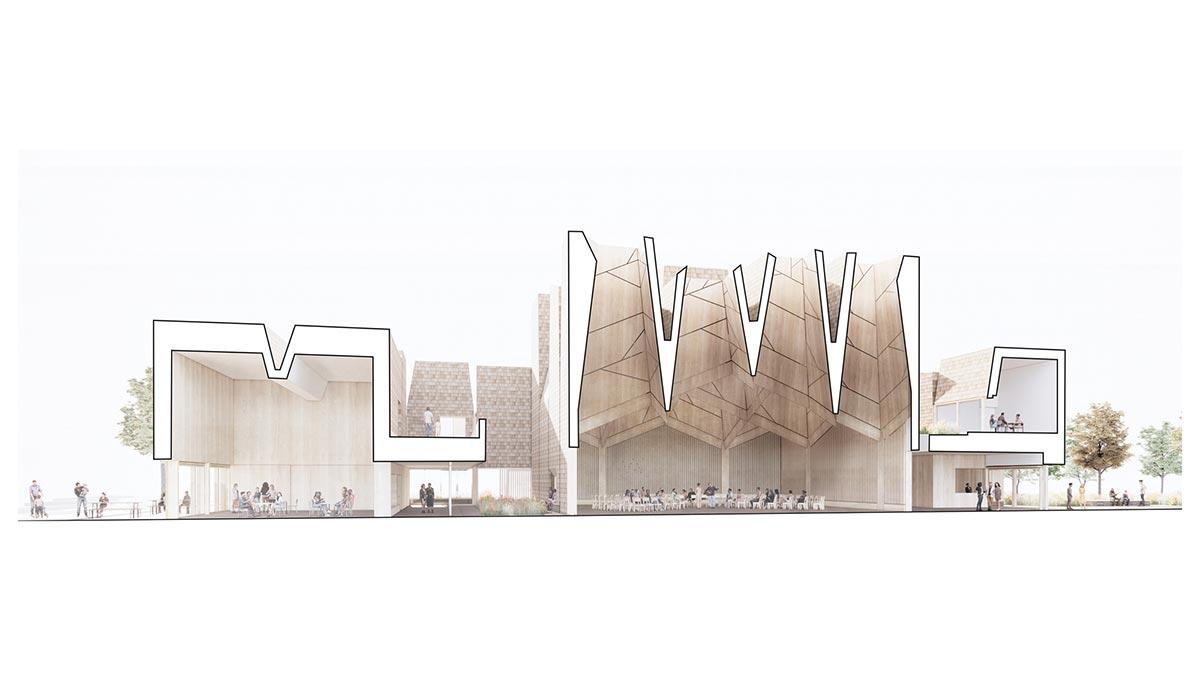
Improving the climate
The new church for Islands Brygge parish aims to generate a feeling of togetherness and inclusion, without any stately grandeur. Inverted projections within the thick façade offer seating niches, insect hotels and book exchange shelves. This turns the exterior of the building into an active public space. The rough shingle façade seems like tree bark and changes its appearance with age and the seasons.
The design concept reflects a modern understanding of spirituality. Instead of heavy stone, like in traditional churches, we are using wood.
Nina la Cour Sell, design director at Henning Larsen
Since a modern church also aims to keep its ecological footprint as small as possible, wood was chosen as the building material as it is climate neutral. “Wood and other renewable, bio-based materials are good alternatives for minimizing the effects of the church construction on the climate,” says la Cour Sell. “As trees absorb carbon dioxide throughout their lifetime, timber construction can help to reduce the amount of carbon dioxide in the atmosphere by extending the carbon cycle. A wooden building becomes a carbon store, so to say.”
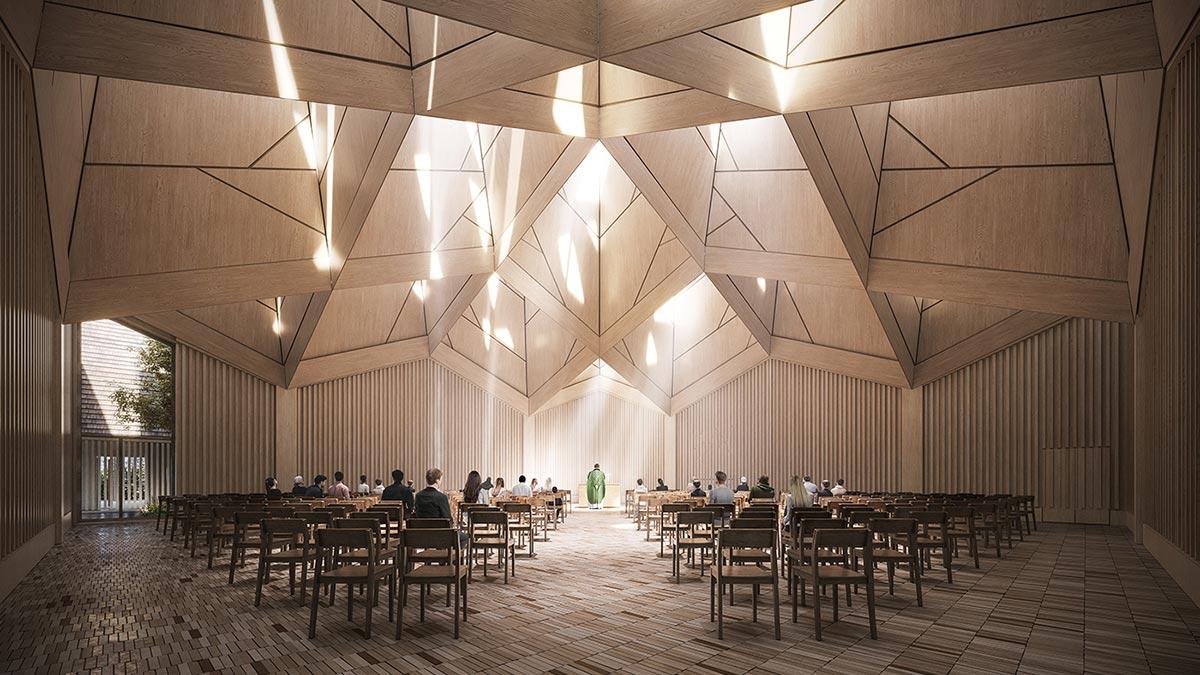
Community and inclusion
Ørestad is a young planned city on Copenhagen island Amager which has experienced a rapid increase in residents over recent years. The mobility concept was developed with the future in mind, and so it is possible to reach the city centre in 7 minutes and the airport in only 6 minutes. Protected natural area Amager Fælled is on its doorstep, with meadows, lakes, woodland and Highland cattle living wild.
As trees absorb carbon dioxide throughout their lifetime, timber construction can help to reduce the amount of carbon dioxide in the atmosphere by extending the carbon cycle. A wooden building becomes a carbon store.
Nina la Cour Sell, design director at Henning Larsen
What this young urban district still lacks are new spaces that are accepted by a broader spectrum of the local community, as was concluded by Copenhagen architectural office Platant in a participatory process. “A new church offers the chance to create a new kind of cultural community space that reflects a modern, inclusive society. A place that welcomes everybody, regardless of where they come from and their belief,” says la Cour Sell, explaining the motivation behind a new church building in current times.
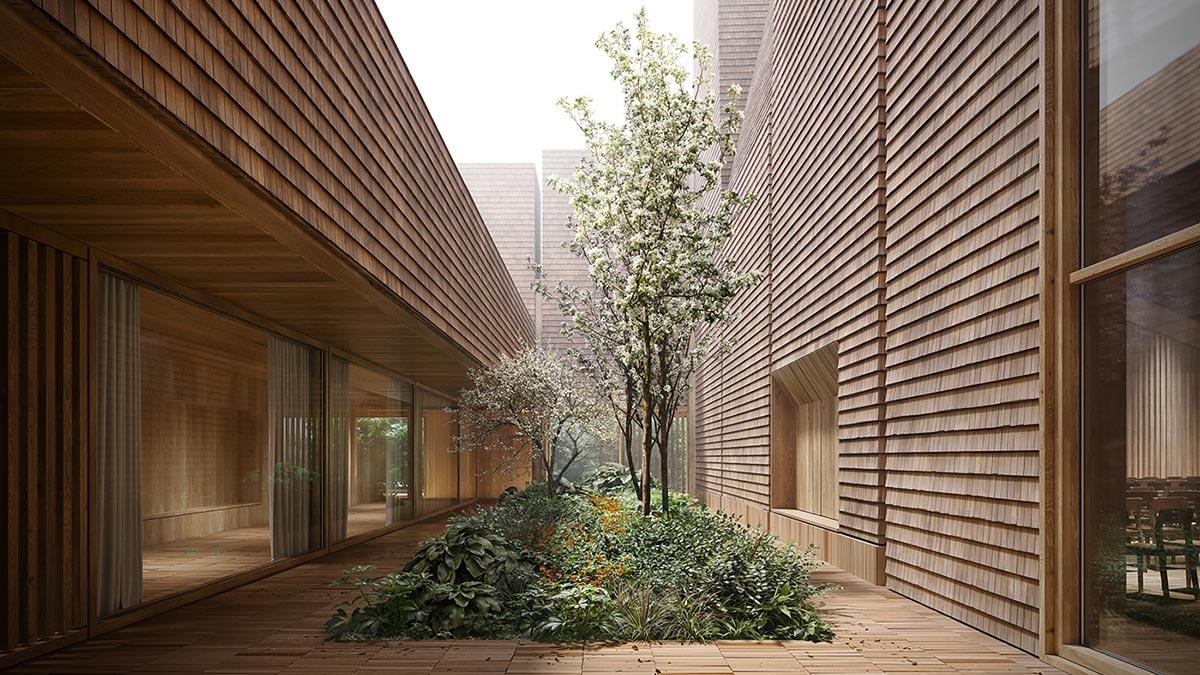
Pioneering architecture
From an architectural perspective, Ørestad Church fits in well with this concept. In the new urban development area at the southern end of Copenhagen, for several years alternative forms of living together, sustainable building materials and pioneering architecture have been explored. This includes Copenhagen’s new concert hall by Jean Nouvel, the Royal Arena by 3XN and the 8 House by Bjarke Ingels, which is Denmark’s largest residential building.
With its sculptural shingle roof, the new church adds a modern monument to the local architecture. Instead of one single overarching shell, the roof consists of cuboid volumes with different shapes. Seen metaphorically, the interplay between these individual cubic structures forms an organic unit – just like the trees in a forest or the members of a community. The roof is an expression of inclusion for a place where the local community is actively invited to meet.
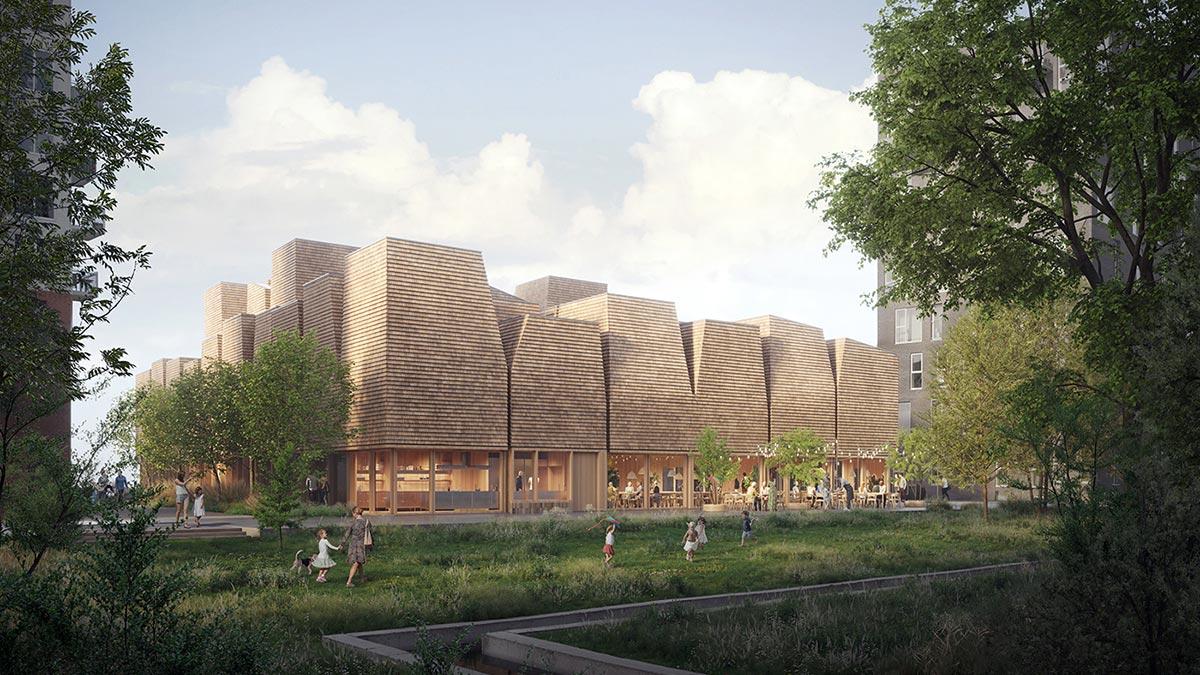
A sustainable landmark
Community project Folkehuset Absalon is very similar in its content. The Lajboschitz family, founders of design discount store Flying Tiger Copenhagen, have bought a former church in the district of Vesterbro and turned it into a successful community centre. Events like Fællesspisning (community dinners), yoga or pottery courses are booked out on a regular basis.
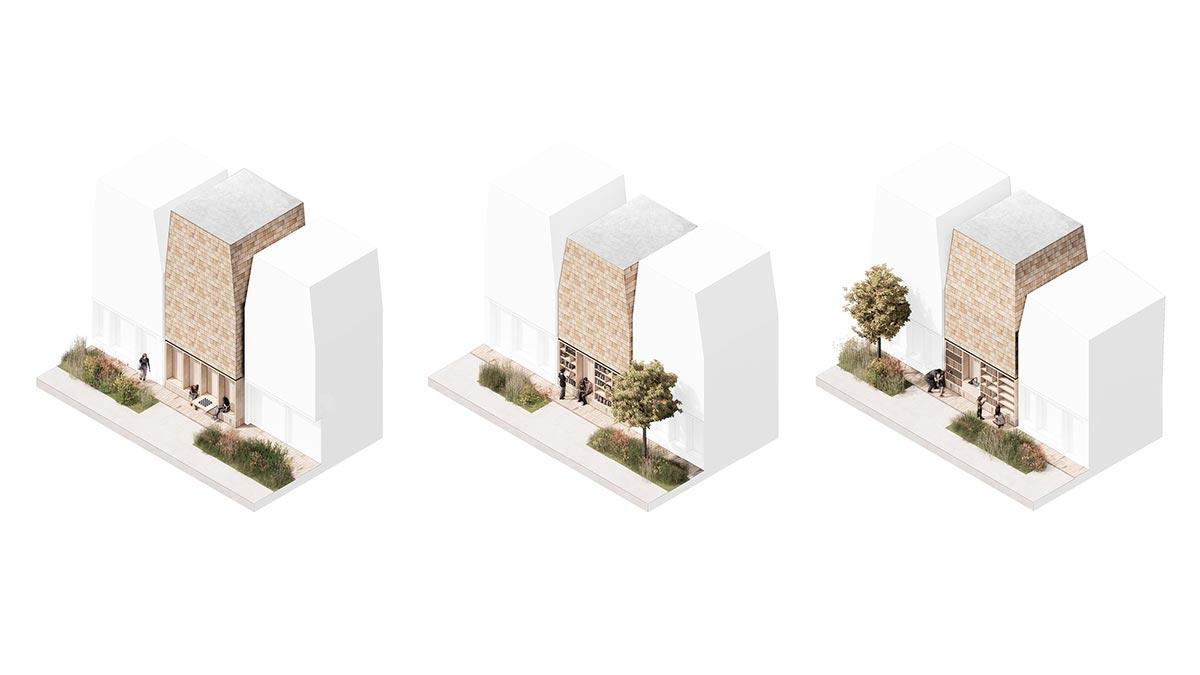
Besides church services, Ørestad aims to offer a broad spectrum of cultural and leisure activities that bring together the people in the neighbourhood. The spatial concept includes a secluded courtyard, an office and multi-use event rooms together with the church building itself.
Henning Larsen’s design shows the concept of a new kind of church that will surely become a social and ecological landmark. Building is scheduled to start in 2024, and consecration is expected in 2026.
Text: Gertraud Gerst
Translation: Rosemary Bridger-Lippe
Visualizations: Vivid Vision, Henning Larsen
More timber construction for Munich
Following completion of Germany’s largest timber housing development in Munich, the city’s first timber hybrid office complexes are now being built. Developed by Accumulata, these projects will offer sustainable workplaces for the future and also construction materials that remain in the loop.
At the turn of the 20th century, railways were seen as the driving force behind industrialization, and railway stations became symbols of progress. Hotels, restaurants and stores in the surrounding area gradually provided infrastructure that was tailored to the needs of travellers. Today, in the transition to the digital age, many of these districts have again become areas of development. Oslo’s Fjordporten and the Gare Maritime in Brussels are just two examples where buildings have been transformed by timber hybrid designs. Munich’s railway quarter to the south of the city also shows how urban structures are changing. Where two hotels once stood, a modern timber hybrid office building called “The Stack” is being developed by real estate company Accumulata in cooperation with Axa Investment Managers.
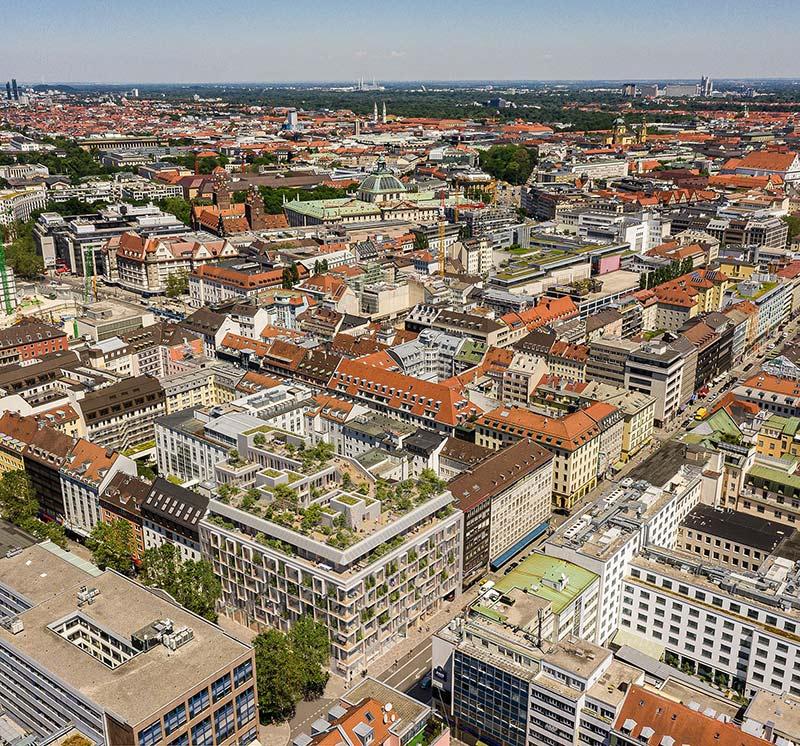
A sustainable mixed-use building concept with timber hybrid architecture aims to help upgrade the railway quarter in the south ecologically, and also improve the quality of life there.
Markus Diegelmann, Managing Partner at Accumulata
Nowadays, climate goals mean that there needs to be a good reason for a new construction. And so the buildings on the corner of Goethestraße/Schwanthalerstraße were first checked to see if they could be adapted. “After examining the existing structures closely, we became aware that they were unsuitable for revitalization,” explains Markus Diegelmann, Managing Partner at Accumulata.
Construction materials remain in the loop
“Instead, a sustainable mixed-use building concept with timber hybrid architecture aims to help upgrade the railway quarter in the south ecologically, and also increase the quality of life there.” The developers chose self-sufficient power generation via solar panels on the roof in order to ensure that the offices can be operated sustainably.
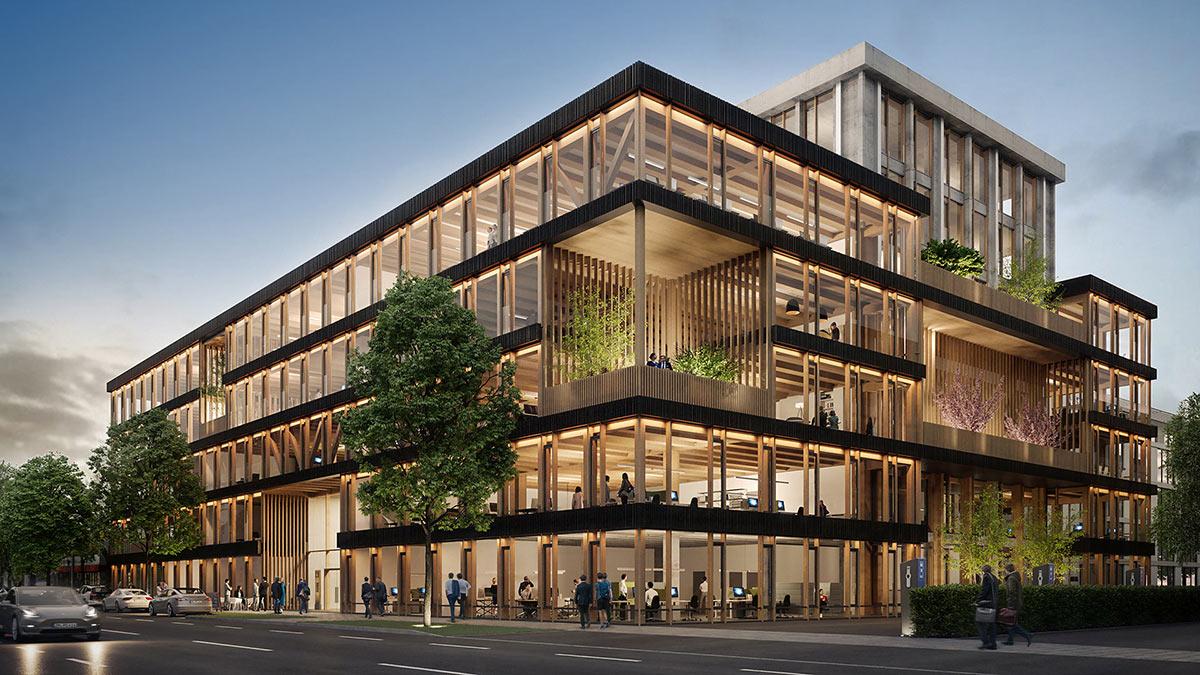
To enable the materials used in construction to be recycled at the end of their useful life, the property will have a Material Passport. The individual construction materials are listed in the cloud operated by supplier Madaster, whose mission is to achieve a “future without waste”. “By closing the loop for all the materials and products used in the construction sector, we are also setting an example for other sectors to follow,” explains the digital start-up.
Visible wooden structure
The new corner building is definitely an eye-catcher in this up-and-coming railway district. Paris-based architectural office Wilmotte & Associés developed a design that is expected to offer space for up to 1,000 workplaces. Its facade consists of a varied grid of projecting glass surfaces and lush green planters. The transparency of the office building firstly creates a connection between inside and out, and secondly gives a clear view of the supporting wooden structure.
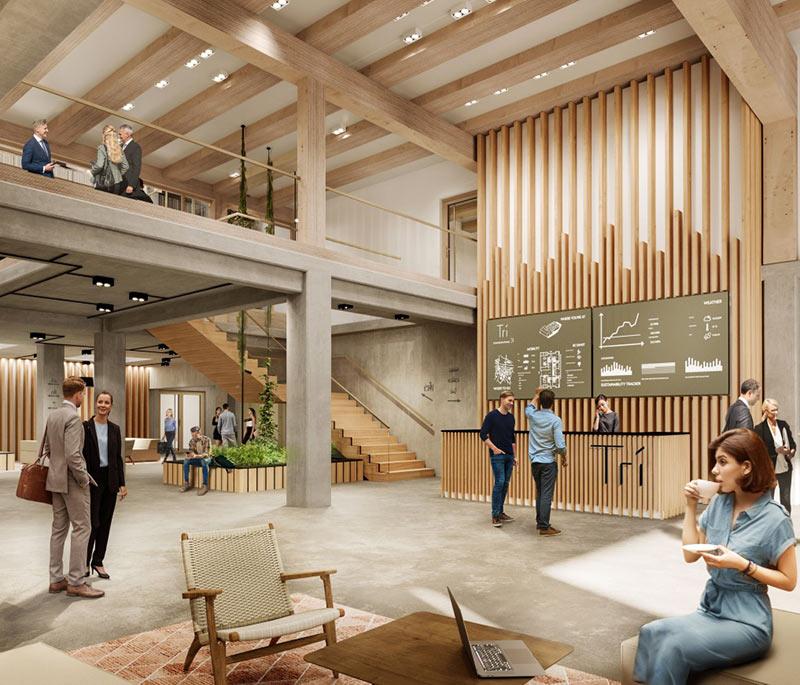
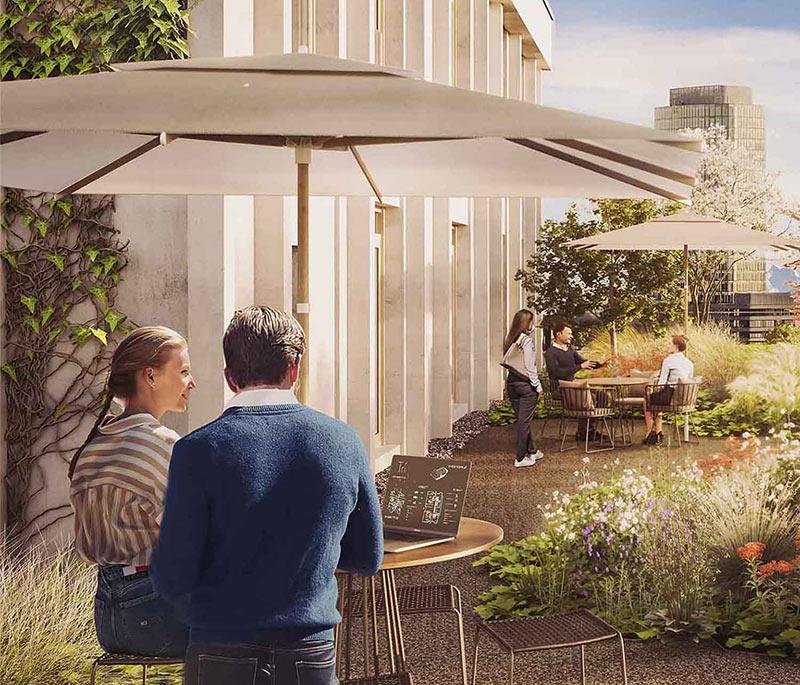
Greening is a key element of the architecture, as a recurring feature of the facade, on the rooftop and in the interior. Inside the bright atrium, trees will spread their greenery up into the first floor, according to the project description. There will be solar panels and also a garden on the roof, where future office users will be able to take a break.
Munich’s first timber hybrid office building
Nature is also used as a design feature for Tri, which has been developed by Accumulata in cooperation with LaSalle Investment Management on Elsenheimerstraße as Munich’s first timber hybrid office building. Recesses in the facade create space for greened loggias, which also attract more attention. “Tri brings nature into the building. As an overarching design principle, biophilic design has been proven to increase creativity and performance,” the project website reads.
Tri brings nature into the building. As an overarching design principle, biophilic design has been proven to increase creativity and performance.
Accumulata and LaSalle, developers
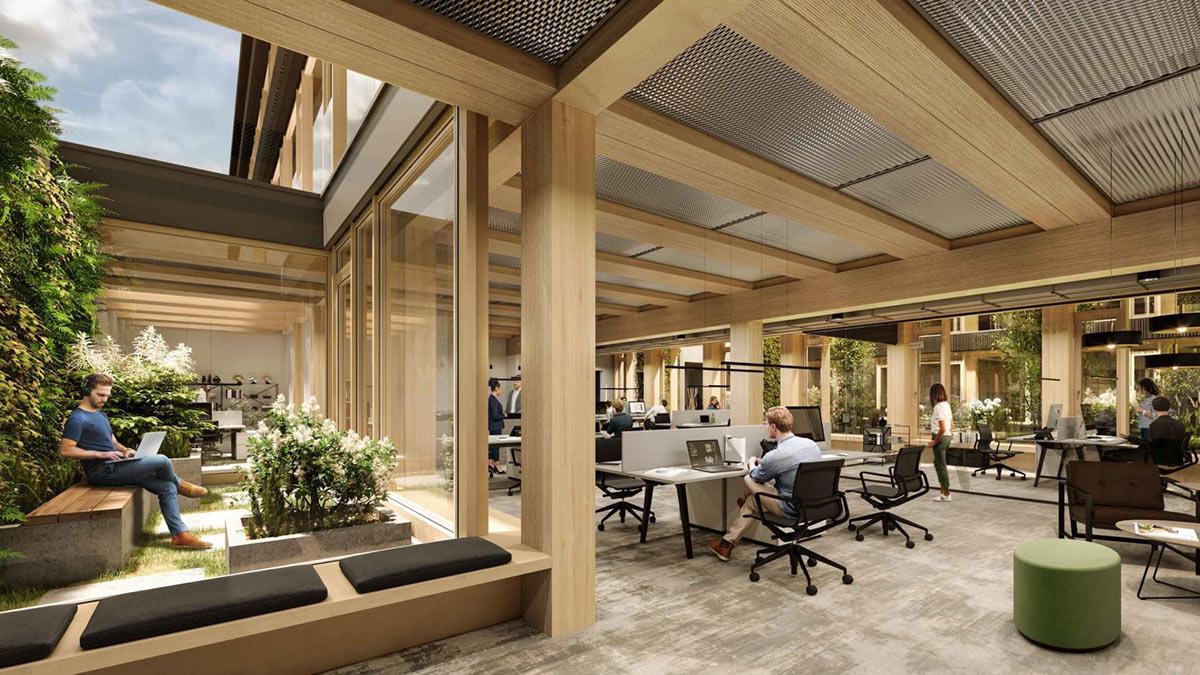
Offices that are resilient to demographic, technological, urban and ecological change will be available on eight storeys with a total of approx. 15,000 square metres of rental space. Smart technology optimizes building services and achieves environmentally friendly operation. “Collectively, the design components form the core of tomorrow’s workplace where people love spending time, while simultaneously helping to minimize the environmental impact,” explains Daniel Manta, project manager at Accumulata.
The city of Munich is already adopting a pioneering role in the area of timber construction. Its Prinz-Eugen-Park is home to Germany’s largest integrated timber housing development. This model ecological settlement also serves as a research project for urban planners, whose goal is to turn Munich into a modern timber construction metropolis. The planned timber hybrid buildings in the railway district and Westend therefore go well with the city’s overall concept.
Text: Gertraud Gerst
Translation: Rosemary Bridger-Lippe
Visualizations: rendart, Oliv Architekten, Accumulata
